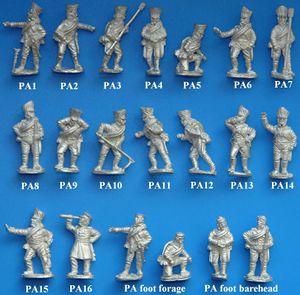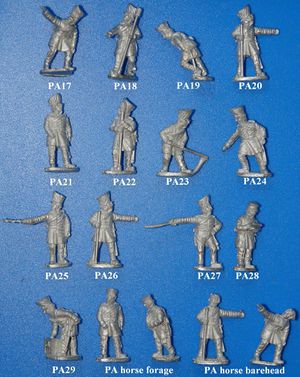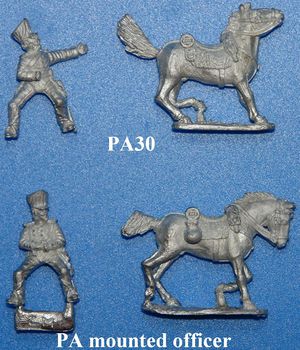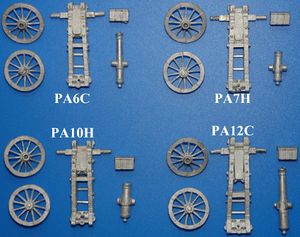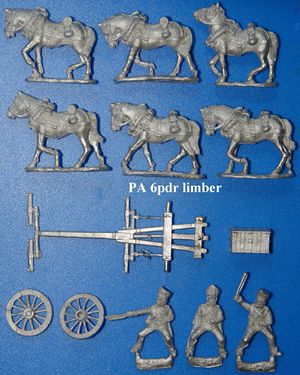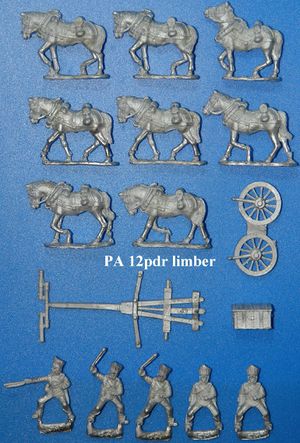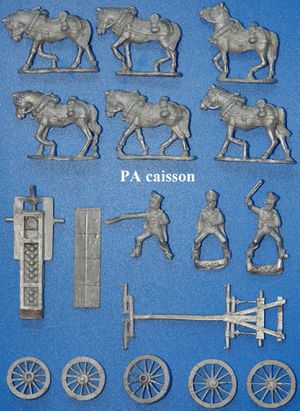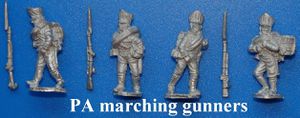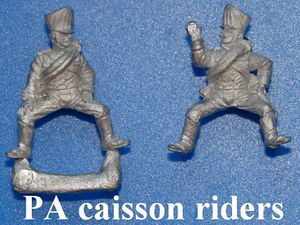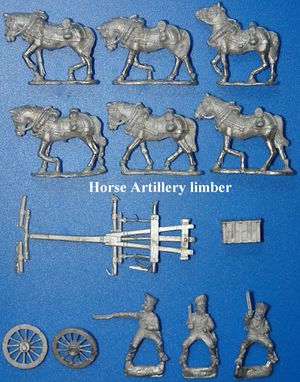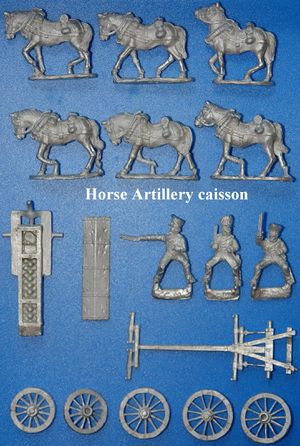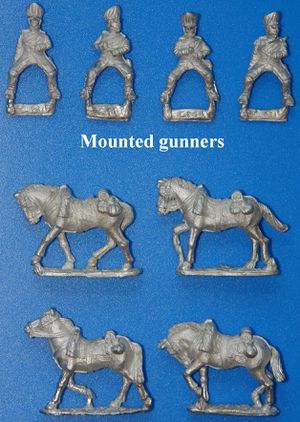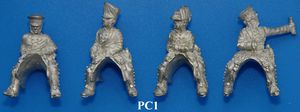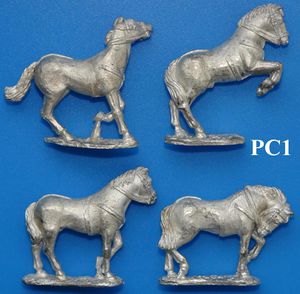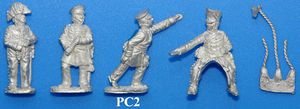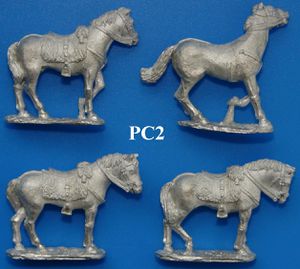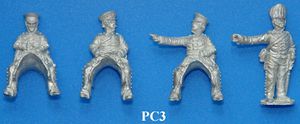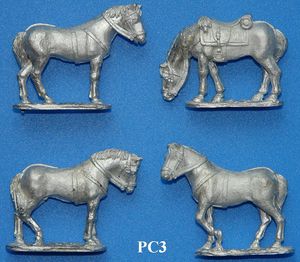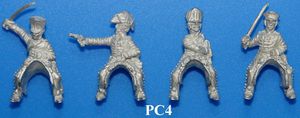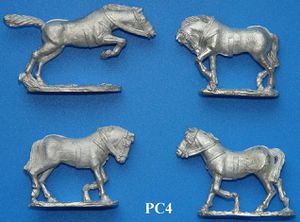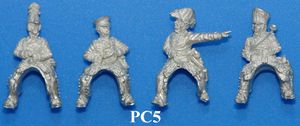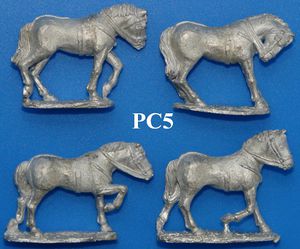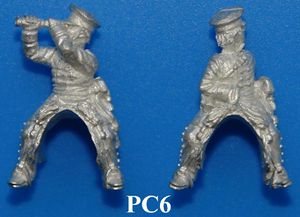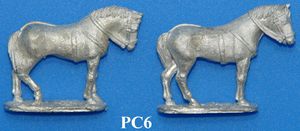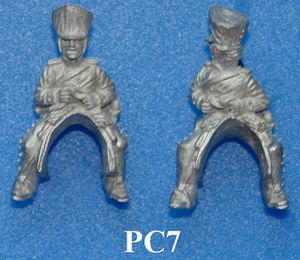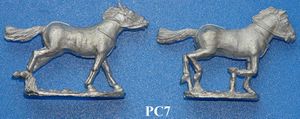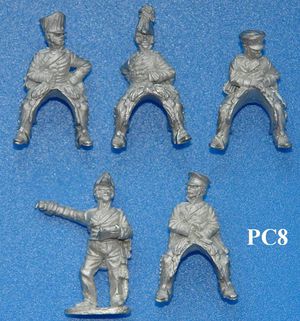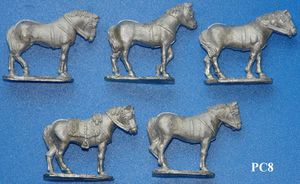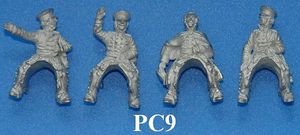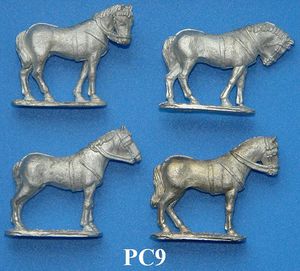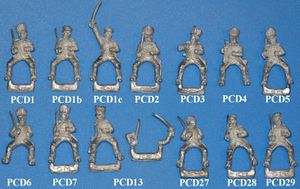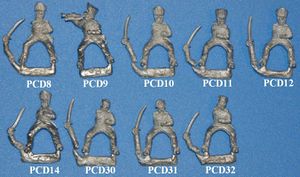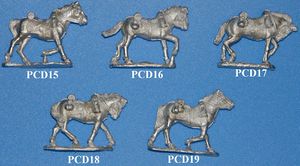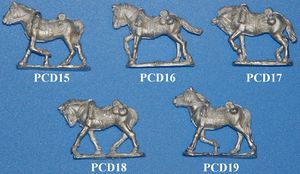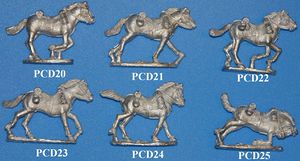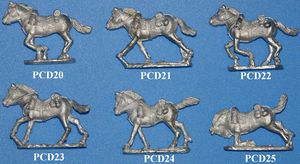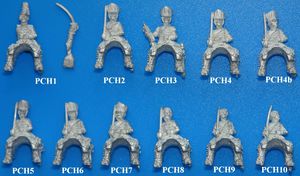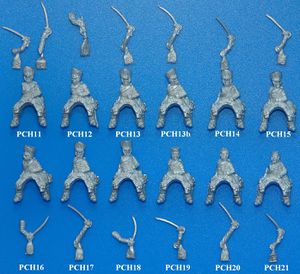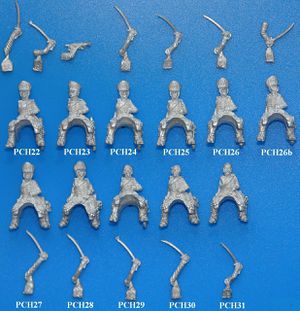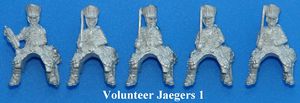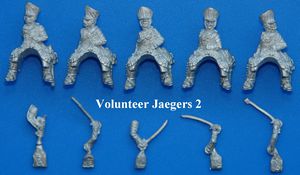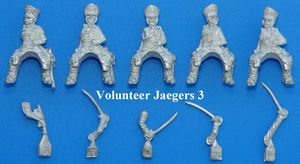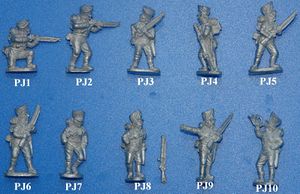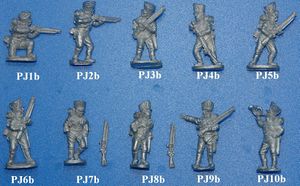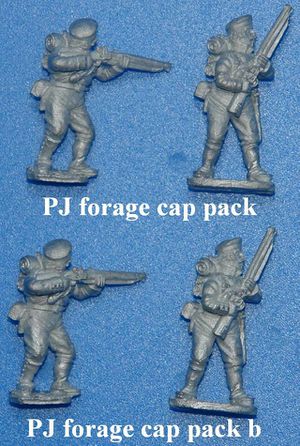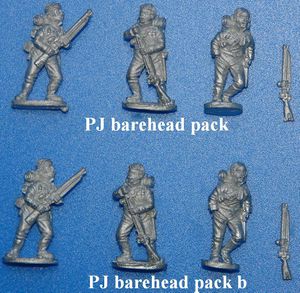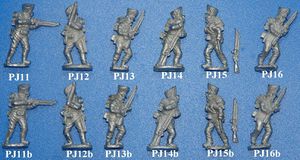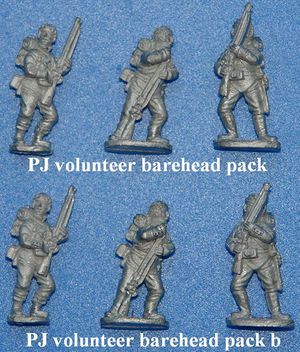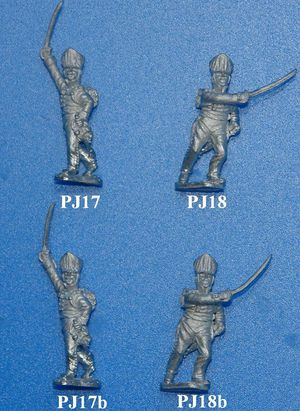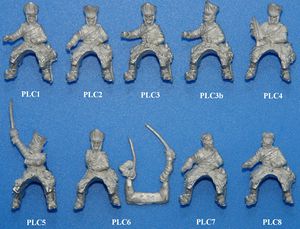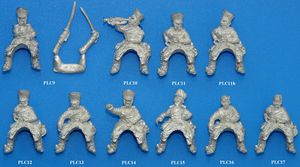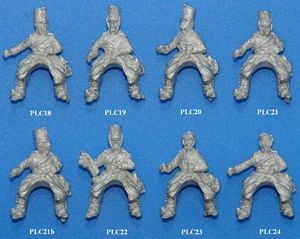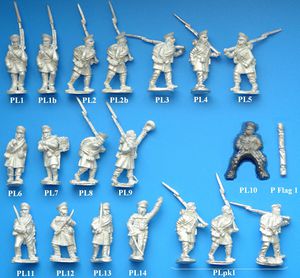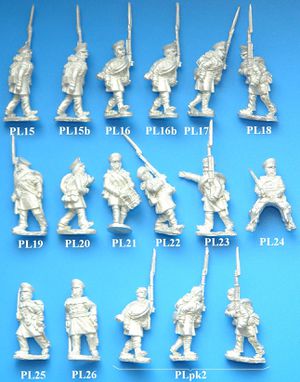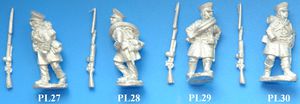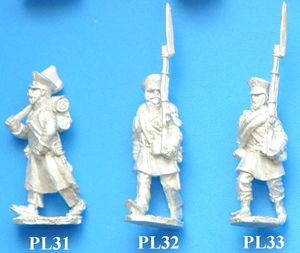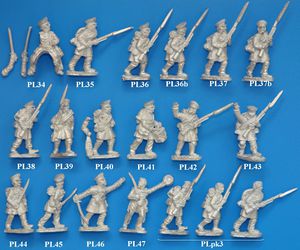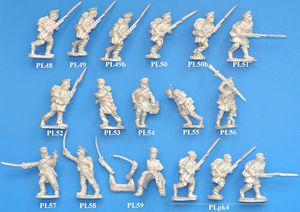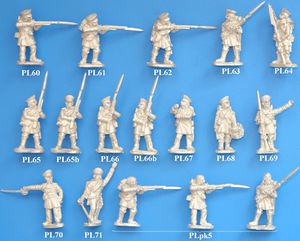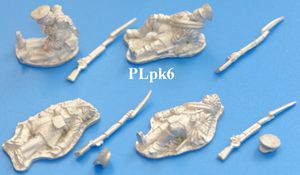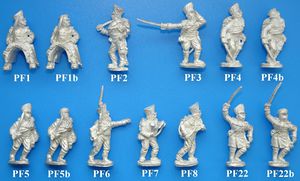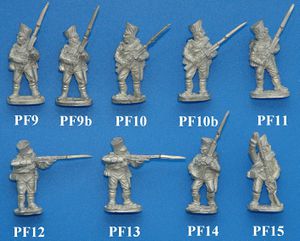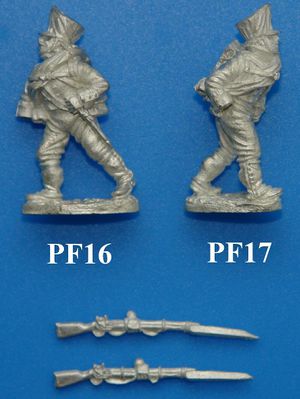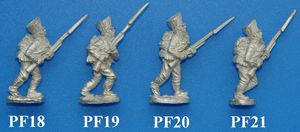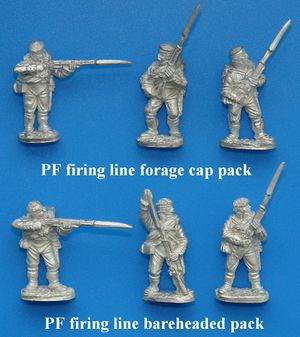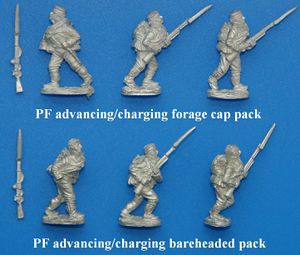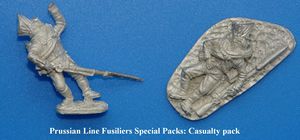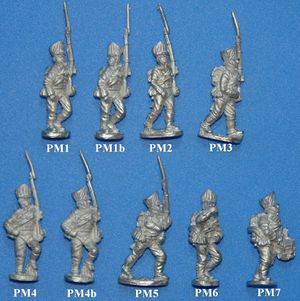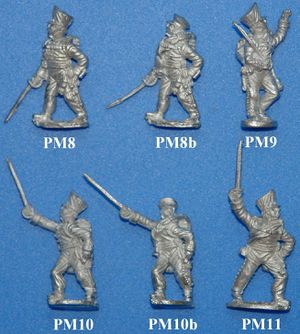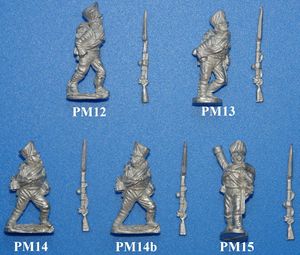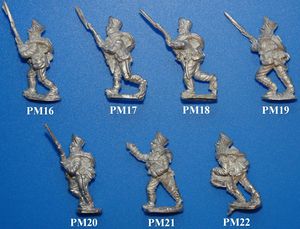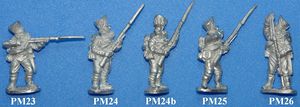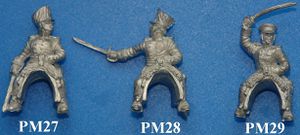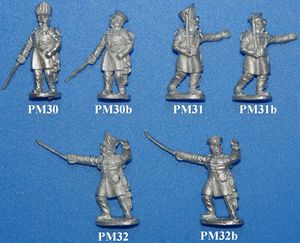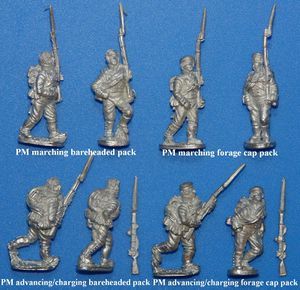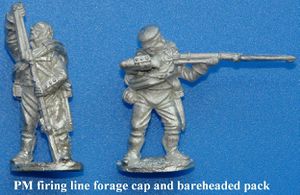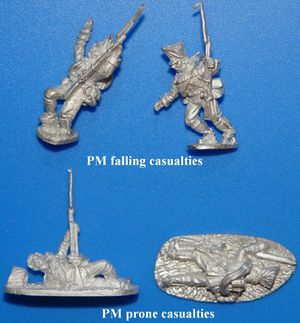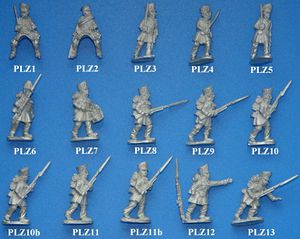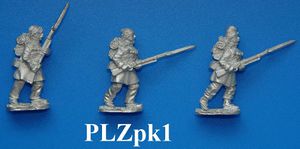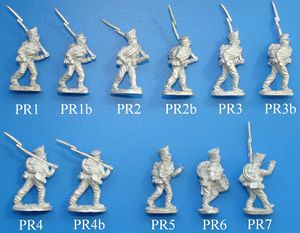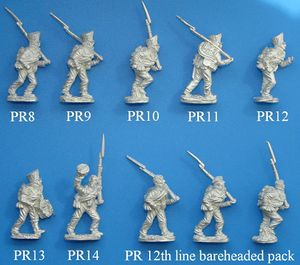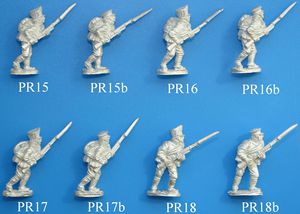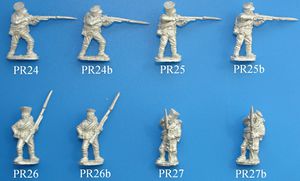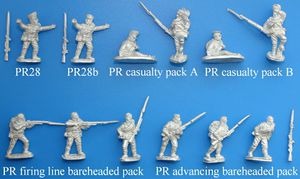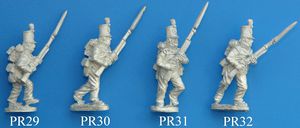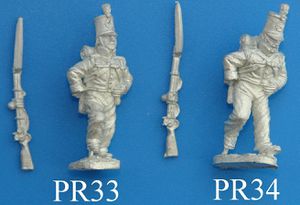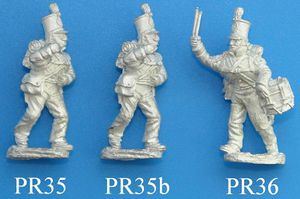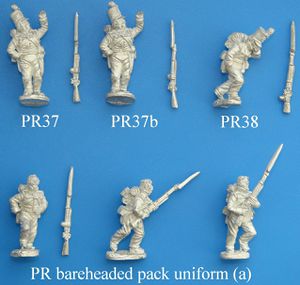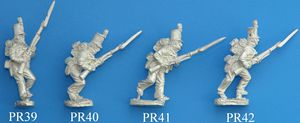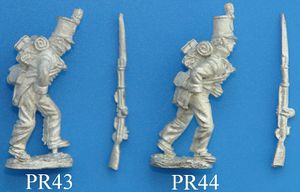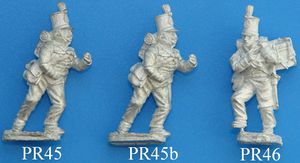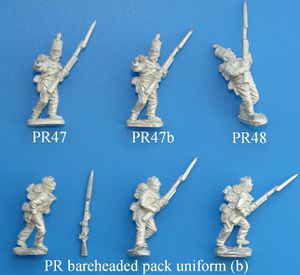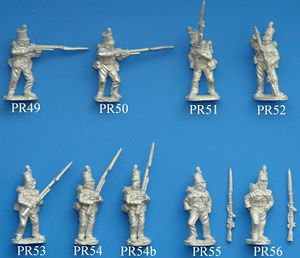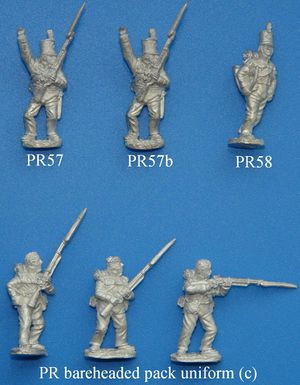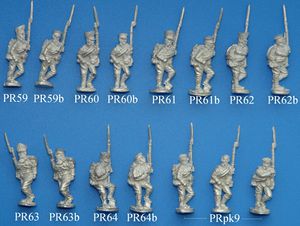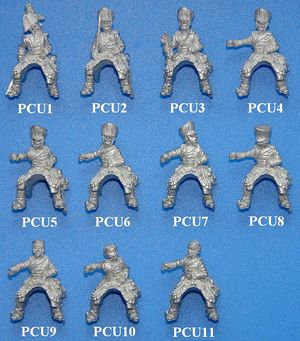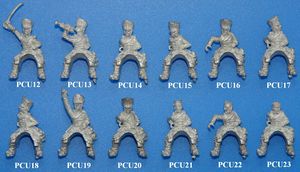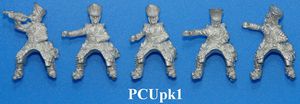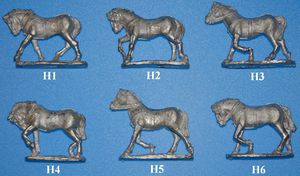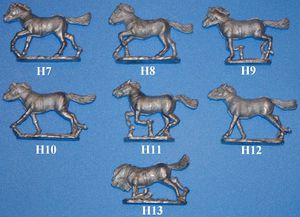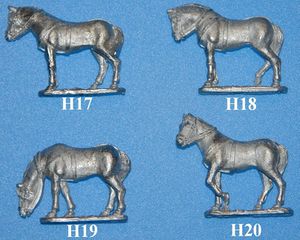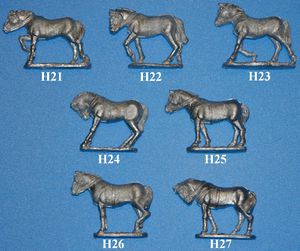Calpe Miniatures Prussian
Содержание
- 1 Artillery
- 2 Command
- 3 Dragoons
- 4 Hussars
- 5 Jaegers and Schutzen
- 6 Landwehr Cavalry
- 7 Landwehr Infantry
- 7.1 Prussian Landwehr Infantry: Route March
- 7.2 Prussian Landwehr Infantry: March-Attack
- 7.3 Prussian Landwehr Infantry: Trail Arms
- 7.4 Prussian Landwehr Infantry: Specials
- 7.5 Prussian Landwehr Infantry: Advancing
- 7.6 Prussian Landwehr Infantry: Charging
- 7.7 Prussian Landwehr Infantry: Firing Line
- 7.8 Prussian Landwehr Infantry: Casualties
- 8 Fusiliers
- 9 Musketeers
- 9.1 Prussian Line Musketeers: Marching
- 9.2 Prussian Line Musketeers: Officers
- 9.3 Prussian Line Musketeers: Trail Arms
- 9.4 Prussian Line Musketeers: Advancing/Charging
- 9.5 Prussian Line Musketeers: Firing Line
- 9.6 Prussian Line Musketeers: Mounted Officers
- 9.7 Prussian Line Musketeers: Foot Officers (Uberrock)
- 9.8 Prussian Line Musketeers: Special Packs
- 10 Lutzow’s Freicorps
- 11 Reserve Infantry
- 11.1 Prussian Reserve Infantry: Officers
- 11.2 Prussian Reserve Infantry: 12th Line Regiment (2nd Brandenburg): 1st Battalion
- 11.3 Prussian Reserve Infantry: 12th Line Regiment (2nd Brandenburg): 2nd Battalion
- 11.4 Prussian Reserve Infantry: Spring 1813 Uniform: Advancing
- 11.5 Prussian Reserve Infantry: Spring 1813 Uniform: Trail Arms
- 11.6 Prussian Reserve Infantry: Spring 1813 Uniform: Standard Bearers and Musicians
- 11.7 Prussian Reserve Infantry: Spring 1813 Uniform: Firing Line
- 11.8 Prussian Reserve Infantry: Spring 1813 Uniform: Specials
- 11.9 Prussian Reserve Infantry: British Manufactured Uniforms
- 11.10 Prussian Reserve Infantry: British Manufactured Uniform (a): Advancing/Charging
- 11.11 Prussian Reserve Infantry: British Manufactured Uniform (a): Trail Arms
- 11.12 Prussian Reserve Infantry: British Manufactured Uniform (a): Standard Bearers and Drummers
- 11.13 Prussian Reserve Infantry: British Manufactured Uniform (a): Specials
- 11.14 Prussian Reserve Infantry: British Manufactured Uniform (b): Advancing/Charging
- 11.15 Prussian Reserve Infantry: British Manufactured Uniform (b): Trail Arms
- 11.16 Prussian Reserve Infantry: British Manufactured Uniform (b): Standard Bearers and Drummers
- 11.17 Prussian Reserve Infantry: British Manufactured Uniform (b): Specials
- 11.18 Prussian Reserve Infantry: British Manufactured Uniform (c): Firing Line
- 11.19 Prussian Reserve Infantry: British Manufactured Uniform (c): Specials
- 11.20 Prussian Reserve Infantry: March/Attack
- 12 Line Uhlans
- 13 Horses
Artillery
This set of figures has been planned and researched for over two years. The main problem has been acquiring reliable information concerning the size, dimensions and construction specifics of the guns themselves. Once again, I must give credit to Peter Hofschroer for providing the detailed information I required. He provided me with a roll of microfilm on which were line drawings of Prussian artillery equipments, drawn between 1815 and 1818. The artillery pieces limbers and caissons described below have been put together using these details.
Prussian Line Artillery: Foot Artillery
The detail for the rammers and handspikes held by the figures described below is taken from the line drawings of the Prussian artillery equipments provided by Peter Hofschroer. The drag ropes which can be seen on the right leg of some of the gunners (taken from the same source) seem to have been attached to a waist belt. One end of the drag rope had a hook on it. This could be detached from the belt and could then be hooked on to the end of a longer rope attached to the gun.
These figures have been designed to fit broadly into three teams:
Loading - Figures PA1 - PA4 Firing - Figures PA6 - PA9 Aiming - Figures PA10 - PA12 PA5 is a general purpose figure. Don’t stick rigidly to the above teams. Mix and match figures from different teams to get the best effect!
I have found no illustrations of NCOs. However, Knotel gives a very complete description of what they looked like in the text which accompanies one of his plates of a foot artillery gunner - "NCOs: golden lace on the collars (and cuffs)...marching boots (allowed by Royal order 1812), small pouches trimmed like those of the gunners, black shoulder belt decorated with brass plate, needles and small chain. Since 1810 The black sabre belt was decorated with the oval brass plate of the fusiliers’ NCOs ."
A passing comment on a Knotel print of an artillery officer inspired the final figure. "The frock coat - in 1808 of grey colour - gradually changed to black (Horse Artillery: blue), black velvet collar with red piping." The forage cap would have been of the same colour as the coat. Trousers, grey with a red stripe down the side. A very distinctive figure!
| Code | Description |
|---|---|
| PA1 | Gunner standing, right arm held up as if giving directions |
| PA2 | Vent man, left arm up, thumb covered with leather protector to fit over vent |
| PA3 | Gunner holding rammer as if about to ram the gun |
| PA4 | Gunner walking holding shot |
| PA5 | Gunner kneeling. This figure is designed to be used with the ammunition chest |
| PA6 | Gunner holding portfire as if about to light fuse |
| PA7 | Gunner standing holding rammer vertically |
| PA8 | Gunner standing holding handspikes |
| PA9 | Gunner recoiling from gun and covering ears |
| PA10 | Gunner using handspike (this figure has a casting sprue which needs to be cut off) |
| PA11/PA12 | These two figures complement each other and are designed to look as if they are in the process of moving the gun wheels while it is being aimed |
| PA13 | NCO holding arm up as if about to give the order to fire |
| PA14 | NCO shouting orders, right hand cupping mouth |
| PA15 | Officer arm raised as if ordering some action stopped. Wears normal field uniform and greatcoat roll |
| PA16 | Battery commander, wearing frock coat (uberrock) and forage cap, looking through a telescope |
| PA foot forage | PA1 and PA5 wearing forage caps |
| PA foot barehead | PA4 and PA8 bareheaded |
Prussian Line Artillery: Horse Artillery
All these figures wear the campaign uniform of the Horse Artillery. The gunners wear the Litewka. This was Prussian blue in colour. Only the collar was in the artillery facing colours (black with red piping). I think the cuffs had a line of red piping along their upper seam, but I have been unable to confirm this to my satisfaction.
Two of the officers (the mounted one and the one on foot pointing with the sword) wear the officer's campaign dress. This was a tail coat very similar to the French surtout, single breasted but seemingly with facing colours on collar, cuffs, turn backs and piping along the bottom edge and breast of the jacket. This was also Prussian blue.
The last officer, wears the uberrock and fatigue cap. I designed this officer with the battery commander in mind, as it was the higher-ranking officers that tended to wear these uniform items. Unlike the infantry officer's uberrock, cavalry officer's coats were made of blue cloth, as was the forage cap. This makes the officer's coat look similar to the gunner's litewka. The main difference was in the quality of the cloth and the tailoring; for example, the officer's collar was made of black velvet. Unfortunately, this is impossible to sculpt into a 25mm figure.
All belts were white leather. Sword scabbards in plain steel for the gunners although officers seem to have had theirs in yellow metal. All leather trappings on the horses in black leather.
Saddlecloths in Prussian blue with two lines of red piping along the edge. The officer's formal saddlecloth was similar to the men's but with five lines of piping along the edge. This is practically impossible to paint on a 25mm figure, so I have made the officer's horse with the more usual sheepskin cover used on campaign.
Note that Knotel shows the trooper's saddlecloth bulging substantially in front of the mounted gunners/troopers. Having done the research; this bulge covered both the brace of pistols and the trooper's greatcoat. How they managed to extract their pistols when required puzzles me!
The valaise on the rear of the saddle and the canteen box were covered in grey cloth and attached to the saddle with black leather straps. The officers seem to have had the edges of their valaise piped in red. The wallet on the side of the saddle contained items for the grooming of the horse, some references state that they carried spare horseshoes. Forage bags were linen coloured or grey.
| Code | Description |
|---|---|
| PA17 | NCO bending down, aiming the gun |
| PA18/PA19 | Two gunners pushing and pulling the gun wheel to align the gun. PA18 hold a ramrod as well |
| PA20 | Gunner walking and looking into leather satchel |
| PA21 | Standing gunner |
| PA22 | Gunner resting on ramrod |
| PA23 | Gunner using trail-spike to align the gun |
| PA24 | Gunner reaching for the ready box |
| PA25 | NCO reaching with port fire to light fuse |
| PA26 | Gunner holding trail-spike and pointing with his other hand |
| PA27 | Standing officer pointing with sword |
| PA28 | Standing officer reading from dispatch wallet |
| PA29 | A special, the result of a spare bit of putty and a bored moment. Gunner about to open ready box. This figure is more expensive as the ready box is cast as part of the figure and has proved a real challenge to cast |
| PA30 | Mounted officer waving arm (includes horse) |
| PA horse forage | PA20 and PA21 wearing forage caps |
| PA horse barehead | PA17 and PA26 bareheaded |
Prussian Line Artillery: Guns and Equipment
Guns Prussian artillery batteries were made up of 8 guns: 6 pounder batteries contained six 6 pounder cannon and two 7 pounder howitzers. 12 pounder batteries were made up of six 12 pounder cannon and two 10 pounder howitzers. When compiling batteries for use with a 25mm army, batteries are usually represented with 4 gun models, 3 cannon and one howitzer (i.e. one model represents two real guns).
These guns have a set of four rings on the tail of the trail through which the handspike would have been fitted to move or aim the gun. The only way this detail could be cast on a gun this size was for the rings to be filled in. It is a simple matter to drill out the rings using a pinvice or twist drill. Alternatively, leave the rings as they are. Once the guns are painted the fact that the rings have been filled is not obvious.
Limbers and Caissons Firstly the reseach has taken ages. I had assistance from Peter Hofschroer who was able to provide copies of original construction drawings for the limbers and caisson. The models I describe below are faithful representations of these drawings in 30mm scale (which is the true scale of my figures). However, the harnessing arrrangement for the team of horses was shown unassembled in the drawings, making it extremely difficult to piece together; especially when the explanation was in old German. Basically, the harness drawings were next to useless. I scoured all my reference material and even wrote to a number of museums. In the end, I was only able to come up with two pictures of Prussian teams. They are both drawings by Knotel of Prussian limbers on the move. The problem with these is that the limbers are both represented moving away from the viewer, so that the harnessing arrangement at the rear of the horse can be made out, but the front is obscured. As a result I can assert that the harnessing at the rear of the horse is correct, but that the front harnessing is a mixture of conjecture, what I could glean from the disassembled drawings and Prussian limbers from later periods (i.e. from the Franco-Prussian war). I have particular concerns about the collar and can only say that it was something like this from what I can see of them in the Knotel drawings. Further headaches started when the pieces were complete and ready to go in the moulds. I wanted to keep assembly to a minimum which resulted in masters that were too big to go in my existing mould cans. I have had to invest in new equipment and learn how to use it.
Lastly, and most directly relevant to the horse artillery, the Knotel drawings made one thing clear - the drivers of horse and foot artillery teams wore uniforms in keeping with the artillery arm they were serving. In other words, there was no single uniform for artillery team drivers. The foot and horse artillery drivers had different uniforms.
These models include a length of copper wire which can be used to form the reins and tracers between the horses and the limber. This is not essential as the limber and horses look right when assembled on a base. However, for those of you who like to put in the finishing touches, I have included the wire.
I suggest that you glue, or preferably solder, the wire to the attachment points on either side of the horse (these are below the saddle and continue on from the length of chain attached to the horse’s collar). Paint the horse and limber but leave the cross pieces at the ends of the limbers unpainted. Now glue or solder the ends of the traces to the unpainted cross pieces and carefully paint the cross pieces and the traces. The pair of horses at the front of the limber do not attach directly to the limber but to the base of the collar on the second pair of horses. Once again I suggest that you attach the traces to the lead pair and leave the attachment points on the collar of the second pair unpainted until you are ready for the final assembly.
The riders horses can be distinguished from the off-side horses by the proper valaise at the rear of the horse. The saddle is also more elaborate and has a saddle cloth underneath it.
| Code | Description |
|---|---|
| PA6C | Six pounder cannon |
| PA7H | Seven pounder howitzer |
| PA12C | Twelve pounder cannon |
| PA10H | Ten pounder howitzer |
| PA 6pdr limber | This limber is for use with the 6 pounder batteries (including the 7 pounder howitzer.) Price includes a team of six horses and three drivers |
| PA 12pdr limber | This limber is for use with the 12 pounder batteries (including the 10 pdr howitzer.) Price includes a team of eight horses and four drivers |
| PA caisson | For use with both 6 and 12 pdr batteries. Price includes a team of six horses and three drivers |
| PA mounted officer | This officer can also be used as a line infantry officer as the only distictive feature of an artillery officer was the colour of the facings. The saddle cloth on the horse is a black sheepskin. The horse and officer are taken from a Knotel print in which he points out that the sheepskin was non-regulation but preferred on campaign (includes horse) |
| PA marching gunners | Four marching gunners. One is a drummer with the drum slung over his shoulder. The second and third gunners have their muskets on their shoulders (one on the left the other on the right). The last gunner carries his musket in the trail-arms manner |
| PA caisson riders | When I was doing the research for the caisson it became apparent that foot gunners often hitched lifts on the top of the caisson sitting astride the lid. This pack contains two figures to sit ontop of the caisson |
| Horse Artillery limber | The same as the 6pounder foot limber, but the drivers wear the horse artillery uniforms. Note that the drivers were made to fit existing horses so each driver will only fit his particular horse |
| Horse Artillery caisson | Same as the foot caisson but with horse artillery drivers |
| Mounted gunners | Gunners on the move to follow the limber or caisson. Four gunners on horses, one is a bugler. Horses included |
Command
Organising Your Command Sets
The Prussian army of this period was organised into three corps. For the campaign in Germany in 1813 these were separated and placed in three of the four allied army groups. Blucher commanded the Army of Silesia but only one of his corps was Prussian (with York in command) the rest were Russian. The commanders of the two other Prussian corps were Bulow and Kliest. For the Waterloo campaign a fourth corps was added and the army operated as a joint entity. In this case the corps commanders were Zieten, Pirch, Thielmann and Bulow.
All corps were organised into four brigades. Each of these had three infantry regiments of three battalions. In 1813 these also had one or two regiments of cavalry attached and at least one 6pdr. battery so that each brigade was a self contained fighting force of all arms. In addition to these four brigades there was a separate cavalry reserve of at least one brigade (some had two cavalry brigades). Each of these reserve cavalry brigades was composed of (at least) three regiments of cavalry. There was also an artillery reserve with its own command element.
This first release of four command sets is designed to cover the four ‘infantry’ brigades that composed the real fighting element of each Prussian corps. Each set is made up of a General, his ADC, a General Staff officer and a Feldjaeger. Command groups for the cavalry and artillery reserves of the corps will follow.
Uniform Notes for the Generals and Their Staff
The preferred order of dress of the Prussian general officer in the field, as well as that of his staff, was the uberrock (frock coat) and the peaked cap. There is little doubt about this although uniform plates of officers wearing these items are rare. This ‘undress’ clothing was considered personal rather than regulation wear, so it was not a uniform item in reality. What this means is that the cut of the Ubberock was not prescribed, it was down to the officers’ (and their tailors’) fashion sense so making it difficult for an artist to represent a ‘standard’ uberrock (this information supplied by Peter Bunde). Infantry generals (and their staff) had grey uberrocks and caps, cavalry had blue ones. The lapels of the uberrock were lined in red and could be turned back to expose a flash of colour at the neck. The cuffs were plain. There is evidence in some of the better battle paintings that many officers’ uberrocks may have had the buttons and retaining straps sewn onto the garment at the shoulder to enable them to attach shoulder straps or epaulets. It is rare to see shoulder straps or epaulets on the uberrock so these attachments remained unused. I have sculpted the buttons and retaining straps on the figures for the sake of historical accuracy; the buttons should be in gold and the retaining straps in silver.
Generals sometimes wore their Kleine uniform in the field. The literal translation of this is the ‘Little uniform’ a better translation might be the ‘simple’ uniform. This was basically a blue kollet with red collar, cuffs and turnbacks. There was no lace on collar or cuffs. The cuffs were ‘Swedish’ cuffs with two gold buttons as the only decoration. The shoulder straps were plaited silver wire. The ADCs and other staff officers often wore the Liebrock on campaign. This was blue for both infantry and cavalry ADCs. The jacket was single breasted and had a large fold down collar. This collar was green for ADC’s (frequently, but not always, piped in red) and red for staff officers. The Swedish cuffs were similarly coloured. Turnbacks were red for infantry officers and white for cavalry. The field of the shoulder strap also differed for cavalry and infantry officers. It was white for the former and blue for the latter. The officer’s rank lace on these epaulets was silver for both. The lapels of the Liebrock were also lined in red and could be turned back to expose the coloured lining.
Officers were not supposed to wear the silver waist sash when wearing the uberrock or the Liebrock. This regulation was generally disregarded and most officers wore the sash in the field with both items of clothing (although it seems to have been less frequently used with the Liebrock).
All officers’ saddle cloths are described as being made of black bear fur. Generals and staff officers had ‘guard’ stars at the rear of the saddle cloth and on the pistol holster covers. ADC’s had no stars on their saddle cloths. The stars were silver with an orange centre.
Many officers wore medals and other decorations on their coats. These were principally iron crosses of various classes but generals also wore a silver star to the left of their chest. All coat buttons were in yellow metal. Sword straps were silver.
The General Staff Officers
Although I have described the uniform details above, I need to emphasise the importance of these officers in the context of these brigade command groups. Until I did the research I did not appreciate the special status of these officers in the reformed Prussian command setup. Each brigade and corps commander had a general Staff officer attached. These can best be described as a parallel commander. The General Staff officer’s job was to remind the brigade commander of the army’s plan of action and to ensure that the General’s actions complied with this plan. He was an advisor to the brigade commander but not a subordinate as such. He was answerable only to the head of the General Staff (Gneisenau, after Scharnhost was injured) who in turn reported directly to the king. It would be fair to say that the brigade was under dual command, the general gave the orders but only as long as these complied with the plans of the General Staff!
The Feldjaegers This corps was a legacy from Fredrick the Great. They were the staff couriers and guides. All the men in this formation were either NCOs or officers. Their special status was reflected in their uniforms, not only were these green in colour, but the NCOs uniforms were cut like the officers’ so that they had long tails and officer-type shoulder straps. Officers and NCOs uniforms differed only in that the officers wore the silver waist sash and had silver rank distinctions on their shoulder straps. The NCOs had gold piping on their shoulder straps and no waist sash.
All Feldjaegers wore green jackets with red collars cuffs and turnbacks and grey cavalry overalls. The field of the shoulder strap was green. On campaign the covered shako completed the uniform. They all carried sabres in white metal scabbards and a red leather satchel for carrying dispatches and orders. The saddlecloth was green with a broad yellow edging stripe. They also carried a brace of pistols in bearskin covered saddle holsters.
Assembly Notes
Most of these figures have been designed to fit specific horses. Some of these figures are the first to be sculpted to fit on Alan Marsh’s ‘Dynamic’ horses. These figures come in a plastic bag with the horses they are designed to fit. The exception to this is in Set Two. Since three of the figures are standing, their horses are designed to look as if they are tethered together. There is a sprue in the pack with lengths of metal rope which will need to be glued to the holes in the horse’s heads to make them look as if they are tied together (the central horse in the group is the one with three holes in it’s head). Some filling may be required. The long length of rope goes from the central horse’s head to the hand of the ADC. Set Three also has a standing feldjaeger figure holding the reins of his horse. Note the point on the left of the horse’s head where the feldjaeger’s fingers have made an impression in the reins to mark the point where the two figures join.
| Code | Description |
|---|---|
| PC1 | The brigade commander is watching the attack through his small telescope. He likes this telescope as it fits into his coat pocket when not in use. The three battalions of his Landwehr regiment took the village this morning but were thrown out in disarray by a concerted Saxon counterattack. To their credit the Landwehr infantry regrouped on reaching his lines and are now supporting his reserve infantry battalions as they try to force the stubborn Saxon infantry out of the village. As he watches he suddenly sees the Saxons streaming out of the other end of the village, running towards the cover of the woods. He snaps his telescope shut and whirls round in the saddle to get his brigade cavalry to intercept the fleeing Saxons. As he turns he pulls on the reins causing his horse to shy back. The sudden movement startles the staff officer’s horse and it rears up. The staff officer manages to keep his seat and brings the animal under control. Meanwhile, the ADC has spurred his horse towards the General and leans forward in his saddle so that he can hear the orders over the noise of the continuing battle. At a discrete distance, the Feldjaeger officer watches and prepares his leather satchel for the stream of orders which he knows will now follow.
The uniforms (and telescope) details are taken from a Brauerbogen plate. The general wears his Kleine uniform with the unbuttoned uberrock over the top and a covered cap as headgear. The General Staff officer is in uberrock and cap with his notebook tucked into the front of his uberrock. The ADC wears his kollet and bicorn in a weatherproof cover. The feldjaeger officer wears the standard uniform (note the waist sash). |
| PC2 | The General and his staff stand on a hill to the left of the road to Berlin. Below him he can see his brigade in their battalion formations straddling the road. His brigade is acting both as the Corps reserve and as the cover for the road to Berlin. This is the Corp’s escape route should things go badly for them today. He watches through his telescope as two of the other brigades from his corps engage Oudinot’s army of Berlin in an attempt to stop its advance towards the capital. His ADC stands behind him holding the tether which keeps their horses from bolting. The action commenced several hours ago and reports so far seem encouraging. The general hears galloping behind him. He turns in time to see a Feldjager NCO rein in his horse while holding out a parcel of orders. The General Staff Officer is already striding towards the courier, arm outstretched. Action at last!
The General and the General Staff officer both wear the Uberrock and cap. The latter has a map case slung over his left shoulder. The ADC wears his Liebrock without his sash and a covered bicorn, a uniform pared down for action. The Feldjaeger NCO is in the regulation uniform. |
| PC3 | The General knows what his brigade has to do this morning. If his men do not hold Ney’s troops back from the approaches to the river they will harass Bernadotte’s army of the North as they cross the pontoons in their effort to link up with Blucher’s army of Silesia outside Leipzig. He is fully aware of how little it takes to discourage Bernadotte. Both his corps commander and the General Staff officer on his staff have made it abundantly clear. Ney’s troops are battered but not beaten. They are still capable of inflicting a severe reverse which will impact immediately on Bernadotte’s resolve. He sits on his horse, carefully going over the plan again. He points out where he wants his dispositions. His ADC takes notes, resting his notepad on the front of his saddle. The General Staff officer sits to his right, listening and adding the occasional comment. The Feldjaeger NCO stands by his horse, ready to mount as soon as the ADC hands him the orders.
All officers wear the uberrock and cap. The General Staff officer has his cap covered and has a map case slung over his left shoulder. The ADC has a telescope case slung from his left shoulder. The Feldjaeger wears the regulation uniform. |
| PC4 | The armies have finally linked up and Napoleon is trapped inside the city. The General’s brigade is leading the Corp’s attack through the outskirts of Leipzig. Yesterday’s battle did not go well and his losses were greater than he would have liked but the Saxons have defected and Napoleon’s position is not good. He watches as his battalions press forward. There is a shout to his left. He turns his horse and sees a Feldjaeger NCO galloping towards him pursued by three French Chasseurs. The General Staff officer has already pulled out a pistol. His ADC draws his sword and spurs his horse forward. The General grasps the hilt of his sword but pauses as the Feldjaeger’s horse leaps over the bushes bordering the field. At that moment, the General Staff officer fires his pistol. The lead chasseur’s horse tumbles and rolls, trapping his rider beneath him. The other two chasseurs turn their horses and gallop back towards their own lines.
Uniforms from Knotel’s painting of the death of Hessen-Homburg (a Brigade commander in Bulow’s corps). The general wears the Kleine Uniform with a covered shako. The General Staff officer wears his Liebrock (in this case with a sash) and a covered bicorn. The ADC wears his Kollet but with his peaked forage cap. The Feldjaeger wears regulation uniform. |
| PC5 | When the order came that he was to break off the pursuit of the routing enemy troops the general found it hard to contain his anger. Looking back now there was no doubt that the order had been correct. A brigade of enemy cavalry supported by infantry had appeared on the edge of the battlefield: too late to influence the result of the battle but dangerous nevertheless. He had recalled his cavalry immediately and led his formed reserve of two regiments towards the threat on the army’s flank. He arrived at dusk to see the French forming up on the edge of a wood. Their infantry support could be seen moving through the wood, still in ‘column of march’. He had a split moment to make his decision. He ordered his two regiments to charge the French before they could form up completely. His cavalry had deployed and carried out his orders almost in darkness. He watched as they gathered pace but lost sight of them as they went into the gallop. He was now trotting towards the sound of battle in some trepidation. Have the French broken or did they have enough time to form up before they were struck by his charging troopers?
The general trots forward flaked by his trumpeter and his General staff officer. His ADC has galloped forward to find out the result of the charge. He pulls up his horse as the General approaches points towards the enemy and yells out that the French are routing. This is based on the closing episode of the battle of Gross-Beeren. The French were struck by the Prussian charge in the dark while still in some disorder and confusion. The whole brigade dissolved, most of it galloping into the open ground where the exhausted Prussian army captured them. A large group of French troopers actually rode through Bulow’s headquarters. The General wears his Uberrock (this would be blue as he is a cavalry officer) with the lapels turned back. He also wears his bicorn but without its protective cover displaying the black and white plume. The General staff officer wears his Uberrock and cap (grey for staff officers). The trumpeter is from one of the corps’ cavalry regiments. He wears his pelisse to ward off the cold. The ADC has copied his general’s flamboyance and wears his white Kollet with a covered bicorn. |
| PC6 | He sits on his horse looking at the French through the telescope his ADC has just handed him. He watched all morning as the infantry from both sides fought for possession of this vital high ground — the Denkmalsberg. His guns duelled with the French batteries stationed here and provided the necessary support for the advancing Prussian battalions. The enemy have re-formed around the Dennewitz windmill at the base of the hill. They must know what will follow. They can see his 12 pounders deploying on the crest of the hill. His ADC has turned in the saddle to ensure the batteries are moving into the required positions. Once his thirty-four guns are in position, he can bombard the French infantry before the Prussian attack columns go down to finish the job. The left flank of the battlefield is secure. If they lose the battle it will happen elsewhere.
The battle for the Denkmalsberg and the subsequent battle for the Dennewitz windmill hill are from the opening stages of the battle of Dennewitz. In this case the commander of the Reserve Artillery was not a general but a Lieutenant-Colonel. Both he and his ADC were chosen, not for their command experience, but for their ‘technical’ expertise. It caused some aggravation with the Russian artillery commander (commanding two 12 pounder batteries) attached to the Prussian reserve as he was a full Colonel taking orders from a subordinate. The artillery officers wore either blue Uberrocks for the horse artillery or grey uberrocks for the foot artillery. There was also a growing fashion for foot artillery officers to have their uberrocks made out of black cloth. The choice of colours for the uberrocks of these two officers is up to you. |
| PC7 | I was asked to make these two galloping feldjaegers by several customers who wanted to use them as messengers on the games table. I was gratified recently to see that such messengers can be seen in several places in the diorama of the Battle of Leipzig, made up of ‘flat’ figures, displayed at Torhaus Dolitz museum in Leipzig. This is one of the most visually pleasing and inspiring dioramas I have ever seen and is worth visiting even if you do not really appreciate ‘flats’. The scale of it is magnificent to say the least.
The uniforms of these figures are described elsewhere. |
| PC8 | The Chief of Staff (Boyen) pushes his map case back and settles it so that it rests on the rear of the saddle. At his age, a day in the saddle with a map case banging against the small of his back is a recipe for a sleepless night. He has done his job and has worked out the fine detail of the movements to follow. Earlier, the corps commander (Bulow) spotted the movement in the opposing lines. The French brigade (Oudinot) supporting the Saxons (Reynier) on this wing moving to support the embattled French and Italians on the Prussian left. He realised that if the two Prussian brigades on this wing attacked before the French reserve could be brought into action on the other wing, the Saxon corps would be isolated. The battle could be won on the Prussian right while the French were trying to reinforce the left. Behind him, the Chief of Staff can hear his assistant briefing the promising young staff officer they have chosen to deliver and implement the orders. A Feldjager will accompany the officer with a copy of the orders. He too waits for the briefing to finish. The Chief of Staff looks forward at the General and his ADC. He knows the General has gambled but it is a throw of the dice with the odds in his favour.
The above is taken from the final act of the battle of Dennewitz. It was a battle won and lost on gambles and personality clashes. On the French side Ney’s gamble was to move Oudinot from the left to the right wing. Reynier begged Oudinot to leave him with some of his forces in support but Oudinot, seething from his loss of overall command to Ney, refused and followed his orders to the letter. On the Prussian side Bulow saw his chance and gambled on his attack being successful before Oudinot could add his weight to the other wing. Bulow asked for Borstell’s brigade to support the attack. Borstell had a semi-autonomous command role under Bulow. He overcame his annoyance at having been made subordinate to Bulow and did as he was asked. The result was a Prussian victory. There are five figures and horses (two new ones) in this set. This is just the way the diorama worked out by the time the various protagonists were factored in. They are all supporting cast. The personality figure of your choice will have to be added to complete the set once these are released. I wanted to make the Chief of Staff look more imposing a figure than any common staff officer. I have given him the plumed hat and shoulder straps on his uberrock (which should be grey). His assistant wears more conventional attire with a covered cap and uberrock (grey) but I’ve also given him the shoulder straps as he would have been a fairly senior staff officer in his own right. The junior staff officer is standing, holding his horse and has the more utilitarian garb of an officer exposed directly to battle. He wears the Leibrock (the Prussian equivalent of the surtout) and the coverd bicorn. The Feldjager in this case is an officer and wears his Uberrock which was green — the same colour as his uniform. The general’s ADC is a straight forward figure in cap and uberrock (both grey). |
| PC9 | Prussian High Command (Tauentzien, Bulow, Yorke and Kleist) |
Dragoons
Uniforms
The figures are designed to represent the dragoons, as they would have appeared when on campaign. This is important as they all wear the Litweka as opposed to the Kollet (the dress coat). The Litewka was a thigh length coat that was common in the Prussian army. The Landwehr infantry wore a similar coat. The dragoon’s coat was of a distinctive mid blue shade sometimes described as light blue. In my opinion it was of a stronger hue than that. Vallejo’s range of Model Colour paints make a medium blue that is perfect for the Job (no.963). The regiment’s facing colour appeared on the collar and shoulder straps. The cuffs were left in the coat colour but there was a line of piping in the regimental colour along the upper seam of the cuff.
There is some evidence to indicate that trumpeters did not wear swallows nests on the Litweka. Since this is not conclusive I have gone for the handsomer option and sculpted wings on the trumpeters. The piping on the cavalry musician’s wings seems to have been metallic, not white. Silver or gold lacing matched the button colour, (this varied from one regiment to another). Trumpet cords matched the colour of the wing lacing but contained coloured flecks, possibly in the regimental facing colour.
Leg wear for the Dragoons was the standard grey cavalry overall with a row of buttons down each outside seam. These had black leather reinforcement on the inside leg and round the bottom of the trousers. There was a line of red piping along the outside seam irrespective of the regimental facing colour.
All belts were white. The ammunition pouch was black with a brass plaque, buckle and fittings. The dragoons were armed with a heavy sabre in an iron scabbard. I have found conflicting information as to the hilt on the sabre. Some reliable sources show the sabre with a single bar hilt. Most show the sabre with a three bar hilt. The 'Uniformbogen' plates (a collaborative set of plates by Brauer, Knotel and others) show the three bar brass hilt on one plate and a single bar iron hilt on the other. I decided to go with the three bar hilt as it makes the sabre look more substantial and the dragoons were used as heavy cavalry by the Prussian army. Twenty men in each squadron carried a carbine. These were the 'Flankers.'
The officers on campaign either wore the Ubberock, which looked like the Litewka but was in fact a short greatcoat; or the Liebrock, which was the Prussian version of the French Surtout. The Ubberock had the facing colour on the collar and shoulder straps and a line of piping along the upper seam of the cuff. The Liebrock displayed the facing colour on collar, cuffs shoulder straps and turn backs. There was also a line of piping along the opening seam on the chest. Note the turnover collar on the Liebrock.
Officer’s trousers were more tailored than the men’s and had no leather reinforcement. They had red piping along the outside seams. Belts and armament were as for the men.
All ranks wore a covered shako. The balance of evidence indicates the use of brass chin scales on the shako, not the leather strap, although I have seen plates where the latter are worn. The men’s fatigue cap and the officer’s peaked cap were of the same colour as the coats, with a band in the regimental colour along the bottom edge of the cap. Note that I have sculpted the dragoons with the older style of forage cap. The Uniformbogen plates make it clear that this was the type of forage cap predominant throughout the period (I will have to correct this detail on the forage cap figures for the infantry as well).
Horse Furniture
The dragoon saddlecloth was rounded at both ends. It was the same colour as the dragoon’s coats with two stripes in the facing colour along the outside edge. The outer stripe was thinner, no more than a line of piping. The inner stripe was wider and was separated from the outer stripe so that a line in the saddlecloth colour showed between the two.
All harnessing was in black leather with iron metalwork.
Both the greatcoat roll and the cylindrical valise were of grey cloth. Only the officers had the outside seams of the valise piped in the facing colour. The large canteen was strapped to the rear of the saddle and could be attached on either side of the saddle. It was covered in a canvass coloured cover. The leather pouch, also attached to the rear of the saddle, carried equipment for the grooming of the horse. Some sources say it contained spare horseshoes. All troopers were required to carry sacks containing feed for their horses. These sacks were also attached to the rear of the saddle. The most frequently observed colour for these is canvass but I have also seen them depicted in grey.
Prussian Dragoons: Shouldered Arms
The first set of figures has shouldered arms (PCD1-PCD7). PCD3, the standard bearer is intended for use with both sets.
| Code | Description |
|---|---|
| PCD1 | Regimental officer wearing uberrrock and shako |
| PCD1b | As PCD1 but wearing peaked forage cap |
| PCD1c | As PCD1 but with sword arm extended up |
| PCD2 | Squadron officer wearing liebrock |
| PCD3 | Standard bearer (to be used with both sets) |
| PCD4 | Trumpeter, at rest |
| PCD5 | Trooper, sword inclined away from head |
| PCD6 | Trooper, sword held straight up |
| PCD7 | Trooper, sword inclined towards head |
| PCD13 | Flanker, trooper with carbine. Use one per squadron. Comes with choice of arms to fit shouldered arms or charging sets |
| PCD27 | As PCD5 but bareheaded |
| PCD28 | As PCD7 but with bandaged head |
| PCD30 | As PCD6 but in forage cap |
Prussian Dragoons: Charging
The next set of figures form the charging set (PCD8-PCD14). They all have separate sword arms. PCD13 is intended for use with both sets.
| Code | Description |
|---|---|
| PCD8 | Squadron officer, wearing liebrock |
| PCD9 | Trumpeter, blowing trumpet |
| PCD10 | Trooper, sword arm extended |
| PCD11 | Trooper, slight turn to torso, sword arm bent |
| PCD12 | Trooper, similar to PCD010 but inclined forward and with different wrist position |
| PCD14 | Falling casualty |
| PCD30 | As PCD10 but bareheaded |
| PCD31 | As PCD12 but with bandaged head |
| PCD32 | As PCD11 but in forage cap |
Prussian Dragoons: Special
Although each charging figure has an arm designed to fit it, I realised that the look of these figures could be radically altered by swapping the arms around. I have gone one better by adding a set of spare arms.
| Code | Description |
|---|---|
| PCD26 | Set of eight spare arms. Three are repeats of charging figure arms, the other five are new |
Prussian Dragoons: Walking/Cantering Horses
The first set is made up of 5 horses in walking or cantering poses. These horses are intended for use with the shouldered arms figures.
| Code | Description |
|---|---|
| PCD15 | Officer’s horse. Has no forage bags or canteen |
| PCD16 | Right fore leg up, head up |
| PCD17 | Left fore leg up, head down |
| PCD18 | Left fore leg straight forward, head down |
| PCD19 | Left fore leg straight forward, head up |
Prussian Dragoons: Charging Horses
The next set of 6 horses is intended for use with the charging figures. Mix and match figures to horses but please note that PCD10, 11 and 12 may not fit all of the charging horses due to their active poses.
| Code | Description |
|---|---|
| PCD20 | Officer’s horse, no forage bags or canteen |
| PCD21 | Left fore leg straight forward, both hind legs extended backwards |
| PCD22 | Legs gathered |
| PCD23 | Left fore leg and right hind stretched out but bent |
| PCD24 | Both fore legs straight but left leg forward, onnly right hind leg extended |
| PCD25 | Falling horse for casualty figure |
Hussars
The Figures
These three sets of figures are largely based on the Brigade plates by Peter Bunde. Please refer to the Brigade plates for background information and as a painting guide.
The figures represent the Prussian Hussars, both line and Leib, for the 1807-15 period. You will note the lack of standard bearer in the figures lists. The hussars, being light cavalry, did not carry standards into battle. Furthermore, these regiments were not issued with standards until after the Napoleonic Wars. Another idiosyncrasy of the Prussian hussars is that they rarely wore the Pelisse on campaign. The few reliable images showing them wearing these items in the field generally show them on outpost duty in inclement weather with the Pelisse fully buttoned and used as a coat. It would be incorrect to put a pelisse on a Prussian Hussar of this period on campaign so I have not sculpted them. The regimental officer is based on a recurring image from many different sources, Knotel, Brauer (and now Bunde) among them. The officer's uniform is striking in its plainness when compared to those of the men he commands. This is very Prussian when one considers the simple uniforms of brigade and corps commanders. This officer's Leibrock is Prussian blue (see the Brigade plates) with no lace. The Brigade plates show similarly attired officers in 'walking out' uniform, wearing tight fitting breeches and boots and with a straight bladed sidearm. The Brauer plate shows an officer by his horse wearing his cavalry overalls and the hussar sabre. Since I wanted the officer to be mounted, I have shown him as depicted by Brauer. The rest of the uniform is as shown in the Brigade plates.
A short note about the hussar braiding and sash – the braid on the officer's uniform had closer spacing than that on the men's. I have tried to reflect this in the sculpting of officers and men within the limits of what is possible in 25mm scale. The barrel sash was not a solid belt. Having had a chance to see some surviving Hussar sashes recently (French and Austrian), I was interested to see that they were made of strands of wool held together by the bindings on the barrels. These strands come to a point on both ends of the sash, at the back, where a toggle (usually wooden) allows the two ends of the sash to be buttoned together. This toggle is visible on the back of the sash on some of the figures. The long tassels extend from one of the ends of the sash and are then brought forward and looped over the sash at the front giving the two distinctive tassels always seen hanging down there. Officers had heavier decorations on their dolmans. I have been able to sculpt this detail on their backs but not on their sleeves as it destroyed the proportions of the lower arm. This detail will have to be painted on round the trefoil loops above each cuff.
Catching Points
These are complex castings. I make every effort to give you castings which are as clean as possible, however, in castings of this nature there are always points where little tears in the mould can cause marks to appear on the casting. These are best cleaned before the figure is painted. The points to watch on these figures (from experience casting the master moulds and running the trial castings of the production moulds) are the front of the canteen hanging on the shabraque and the sides of the feet.
Prussian Line Hussars: Shouldered Arms
| Code | Description |
|---|---|
| PCH1 | Regimental officer wearing Liebrock and plumed bicorn. Two arms available. Choose shouldered sword or outstretched arm for charging poses |
| PCH2 | Squadron officer, shouldered sword. Wears the full hussar uniform |
| PCH3 | Trumpeter resting trumpet on his thigh |
| PCH4 | Trooper, shouldered sword sitting straight, looking straight forward |
| PCH4b | Version of PCH4 looking left |
| PCH5 | Trooper, shouldered sword, body turned slightly to the right, looking down |
| PCH6 | Trooper, shouldered sword, body turned slightly to the left |
| PCH7 | Trooper, shouldered sword at a slight angle. Sitting straight but head turned to the right |
| PCH8 | Version of PCH5 wearing forage cap |
| PCH9 | Version of PCH6 bareheaded |
| PCH10 | Version of PCH7, bandaged head |
Prussian Line Hussars: Charging
These figures are two-part castings with the sword arms cast separately from the figure. There are various reasons for this. The most important one is that I got tired of having to dispose of perfectly good castings simply because of flaws on the sword. By casting the sword arm separately I can make casting runs more efficient. Each figure has been designed to suit a particular arm. The number of the arm which best suits each figure is given below beside its code. This number is also engraved underneath the shabraque. To read the number you have to hold the figure upside down as this is the only way the number can be engraved (there is a sprue substructure on each figure which is removed after production casting). Match the figure to the relevant arm and your figure is complete. I make the arms with as much care as possible but the moulding process does lead to differential shrinkage which can lessen the fit between arm and body. For a perfect finish fill in any cracks between the body and arm before painting. Do not worry about the numbers of the sword arm and the figure not matching. This was the original intention but as the range progressed, the numbering sequence of the figures changed beyond the point at which the numbers on the arms could be changed. I am offering the sword arms in a separate pack so that you can customise your figures if you so desire. Be warned, though, every arm will not fit every figure. Due to the way the shoulder joint and arm work together, you may have to alter the arm or the figure by filing or filling to get the figure/arm combination to look right. My grateful thanks to Ian (you know who you are) who did remind me at the start that the Hussars did not 'give point' with their swords as they carried a slashing sword, not the straight sword of the heavy cavalry. Arms are in suitable poses (taken from contemporary illustrations) thanks to him.
| Code | Description |
|---|---|
| PCH11 | Charging officer, two arms available, supplied at random |
| PCH12 | Trumpeter, blowing trumpet. Arm B |
| PCH13 | Trooper leaning slightly forwards, looking straight forward. Arm 16 |
| PCH13b | As PCH13 looking left. Arm 16 |
| PCH14 | Trooper leaning forward, slight twist of the body to the left. Arm 13 |
| PCH15 | Trooper sitting upright body turn to the right. Arm 15 |
| PCH16 | Trooper leaning slightly forwards, head turned to the right. Arm 14 |
| PCH17 | Trooper sitting upright slight turn of the body to the right. This was intended to be the enthusiastic figure but looks as good (or better) as the other hussars so use as normal. Arm 17 |
| PCH18 | Falling casualty figure. Arm C. Use with falling horse |
| PCH19 | Version of PCH15 wearing the forage cap. Arm 15 |
| PCH20 | Version of PCH17 bareheaded. Arm 17 |
| PCH21 | Version of PCH14, bandaged head. Arm 13 |
Prussian Leib Hussars: Charging
These are the famous 'Death's Head' Hussars. I chose the charging poses for these figures because this is how they are usually illustrated. The only short-cut I took when I made these figures was to use the arms I had already made for the line Hussars. This means that arms 13-17 reappear once again. As before, match figure code to arm code (engraved under the shabraque) for best results.
| Code | Description |
|---|---|
| PCH22 | Charging officer, two arm options, one supplied with each figure at random |
| PCH23 | Trumpeter blowing trumpet |
| PCH24 | Trooper leaning slightly forwards, looking straight forward. Arm 16 |
| PCH25 | Trooper, left twist to the body. Arm 13 |
| PCH26 | Trooper, right twist to the body, facing forward. Arm 15 |
| PCH26b | As PCH26, facing left. I like arm 14 on this figure |
| PCH27 | Trooper sitting erect. This was intended to be the enthusiastic figure but is as valid a charging Hussar as any of the other figures, use as normal. Arm 17 |
| PCH28 | Casualty figure. Designed to fit falling horse but I prefer him on a normal charging horse. Arm 16 |
| PCH29 | Version of PCH24 wearing a forage cap. Arm 16 |
| PCH30 | Version of PCH27 bareheaded. Arm 17 |
| PCH31 | Version of PCH25 bandaged head. Arm 13 |
Volunteer Jaegers
I know some of you will be annoyed by the sale of these figures in packs. Unfortunately I really have no option as the figures described above have produced over 40 moulds. The financial and storage implications of this means that I simply cannot afford to sell the volunteers in any other way at present. If I find they sell well, I may review this at a later stage. Each set is made up of four troopers and a trumpeter. They are all conversions of the figures which make up the main sets with added pickers and chains and the new carbine. You will need one of the officers from the relevant sets described above to complete the squadron. Refer to the Brigade plates for accurate information on these figures.
| Code | Description |
|---|---|
| PCHpk1 | Shouldered swords. Line regiments |
| PCHpk2 | Charging. Line regiments |
| PCHpk3 | Charging. Leib Hussars |
Jaegers and Schutzen
Prussian Jaegers and Schuetzen: Line Jaegers and Schuetzen
There were several important differences between the uniforms and equipment worn by these troops and those worn by the rest of the line infantry (musketeers, fusiliers, etc.). They were as follows:
These troops were armed with a rifle not a musket. They wore a dark green kollet. This was cut in the same style as the line infantry kollet. Facings were dark red for the East Prussian Jaegers. Their cuffs had no flap as they were cut round in the Swedish style. The Silesian Schuetzen Battalion had black facings piped in poppy red. They did have a cuff flap in the same green as the kollet. Both jaegers and schuetzen wore a belt round the waist. The purpose of this was to draw the rest of the equipment close to the body to lessen the risk of entanglement. It was not used to carry belly-pouches as was sometimes the case for the volunteer jaegers. The cartridge pouch belt (worn over the left shoulder) was decorated with brass pickers, chains and a flask containing finely ground powder. These were vital pieces of equipment for the function and maintenance of the rifle. They were also armed with a straight sword-bayonet. This was only fixed when absolutely necessary as it interfered with the use of the rifle and increased the risk of snagging. The greatcoats were carried strapped to the top of the pack, not rolled and worn over the left shoulder. These figures are often depicted wearing a greatcoat roll but these illustrations are invariably modern ones. Contemporary sources and the Knotel prints and pictures, always show them with the coat strapped to the pack. This would make sense as a coat roll would negate the issue of the waist belt and once again increase the possibility of entanglement. For the same reason no haversacks were carried on the left hip. The rest of the equipment and uniform items were standard issue: Black canvas knee gaiters. The East Prussians were originally issued with marching boots but they were subsequently issued with gaiters in 1813 and used these on campaign. The Silesians only used gaiters. NCOs in both formations used marching boots to emphasise their status. Grey breeches tucked into gaiters or marching boots. Covered shakoes. Note: there are two variants for each code number. The first is for the East Prussian Jaegers. These figures have Swedish cuffs(round cuffs). The (b) variant of each figure is for the Silesian Schuetzen; these figures have Brandenburg cuffs (cuffs with a flap).
| Code | Description |
|---|---|
| PJ1 | Jaeger kneeling firing |
| PJ1b | Jaeger kneeling firing |
| PJ2 | Jaeger standing firing |
| PJ2b | Jaeger standing firing |
| PJ3 | Jaeger loading, taking round from pouch |
| PJ3b | Jaeger loading, taking round from pouch |
| PJ4 | Jaeger loading, ramming rifle |
| PJ4b | Jaeger loading, ramming rifle |
| PJ5 | Jaeger holding fire, leaning forward |
| PJ5b | Jaeger holding fire, leaning forward |
| PJ6 | Jaeger holding fire, leaning back |
| PJ6b | Jaeger holding fire, leaning back |
| PJ7 | Jaeger advancing, trail arms; right leg straight, left leg forward |
| PJ7b | Jaeger advancing, trail arms; right leg straight, left leg forward |
| PJ8 | Jaeger advancing, trail arms; left leg straight right leg back |
| PJ8b | Jaeger advancing, trail arms; left leg straight right leg back |
| PJ9 | Jaeger NCO, cradling rifle in left arm, directing with right (this figure has a casting runner on the butt of the rifle which needs to be clipped off) |
| PJ9b | Jaeger NCO, cradling rifle in left arm, directing with right (this figure has a casting runner on the butt of the rifle which needs to be clipped off) |
| PJ10 | Jaeger bugler (casting runner on bugle needs to be clipped). A note concerning this figure: I have several illustrations, they concur in showing the bugler holding a horn in the French style not a typical U-shaped Prussian horn, perhaps a distinction of these formations. Furthermore, none show any evidence of cords attached to the bugle; peculiar, but I have decided to go with the available evidence |
| PJ10b | Jaeger bugler (casting runner on bugle needs to be clipped). A note concerning this figure: I have several illustrations, they concur in showing the bugler holding a horn in the French style not a typical U-shaped Prussian horn, perhaps a distinction of these formations. Furthermore, none show any evidence of cords attached to the bugle; peculiar, but I have decided to go with the available evidence |
| PJ forage cap pack | Versions of PJ2 and PJ6 wearing forage caps |
| PJ forage cap pack b | Versions of PJ2b and PJ6b wearing forage caps |
| PJ barehead pack | Versions of PJ4 (barehead), PJ5 (bandaged head) and PJ7 (bald) |
| PJ barehead pack b | Versions of PJ4b (barehead), PJ5b (bandaged head) and PJ7b (bald) |
Prussian Jaegers and Schuetzen: Volunteer Jaegers
These troops were all volunteer riflemen attached to line formations. Most regular line battalions had a company of these troops attached to them. They were generally young men from the professional or wealthy classes. As such, they were expected to provide their own equipment and uniform. The result of this was a proliferation of personalised equipment and uniform items that make these units particularly interesting. I have come across many illustrations of these troops, none bear a "standard uniform". Some of the uniform features might seem over ornate for an infantry soldier but these formations were considered to be training cadres for the line officers and NCOs of the future. The common features are as follows:
They all wore a dark green coat based on the kollet with facings in the same colour as that of the parent formation (i.e. if they were attached to a Pomeranian unit they had white facings). They wore covered shakos on campaign. The principal differences were as follows: Many volunteers had a second cartridge pouch attached to the front of the belt (the belly pouch). Some wore breeches tucked into marching boots, others wore trousers, often with a red stripe running down each outer seam. Some men wore shakos in the Austrian style with peaks front and back. Some formations preferred Swedish cuffs (round), others chose the Brandenburg cuffs (with flaps). I like to add a company or two of volunteers to each line regiment. When putting these together I use all the different styles within the company to reflect the personal uniform preferences of the men. The only unifying theme I maintain is whether the jackets have cuff flaps or not. This varied from company to company, even within the same regiment.
Note: as above, these figures have two variants. The ones with the (b) code have cuff flaps the others have round cuffs.
| Code | Description |
|---|---|
| PJ11 | Volunteer firing. Breeches tucked into boots. Belly pouch |
| PJ11b | Volunteer firing. Breeches tucked into boots. Belly pouch |
| PJ12 | Volunteer holding fire. Breeches, boots, belly pouch |
| PJ12b | Volunteer holding fire. Breeches, boots, belly pouch |
| PJ13 | Volunteer loading. Taking round from pouch. Trousers rolled up, belly pouch |
| PJ13b | Volunteer loading. Taking round from pouch. Trousers rolled up, belly pouch |
| PJ14 | Volunteer loading. Ramming rifle. Long trousers |
| PJ14b | Volunteer loading. Ramming rifle. Long trousers |
| PJ15 | Volunteer advancing, trail-arms. Trousers, belly pouch |
| PJ15b | Volunteer advancing, trail-arms. Trousers, belly pouch |
| PJ16 | Volunteer running, high porte. Long trousers |
| PJ16b | Volunteer running, high porte. Long trousers |
| PJ volunteer barehead pack | Versions of PJ12 (bandaged head), PJ13 (barehead) and PJ14 (bald) |
| PJ volunteer barehead pack b | Versions of PJ12b (bandaged head), PJ13b (barehead) and PJ14b (bald) |
Prussian Jaegers and Schuetzen: Officers
Initially I had no intention of making officers for this set of figures, as their uniform was identical in cut to that of the fusilier officers but in dark green. However, as this set of figures progressed I felt a couple of officers were required to complement the skirmish poses, so I made them! (as they stand, they can be used for fusilier officers if you paint their jackets Prussian blue and choose the variants with the cuff.
| Code | Description |
|---|---|
| PJ17 | Officer advancing, holding sword up |
| PJ17b | Officer advancing, holding sword up |
| PJ18 | Officer running, pointing with sword |
| PJ18b | Officer running, pointing with sword |
Landwehr Cavalry
The figures in the lists below are designed to represent Landwehr cavalry in the «regulation» uniform. Those of you who know something of this arm of the Prussian cavalry will be aware that this uniform was not standard throughout the landwehr cavalry regiments. Two regiments, one Silesian, the other from Brandenberg, must have had a wealthy benefactor as they were provided with the full Polish lancer uniform. Several other regiments adopted versions of the regulation uniform but gave it regimental distinctions. One Brandenberg regiment used the Landwehr cap; two others from the same province were issued with the British stovepipe shako and were provided with a very distinctive saddlecloth (more later). Another common variation was to make the regulation uniform in a different coloured cloth. One regiment from East Prussia had light blue litewkas, a Pommeranian regiment made theirs out of dark grey cloth. Having said this, the regulation uniform was worn by most regiments. I have made a rough estimate of the ratio of regiments which wore the regulation uniform to those that did not. Across most provinces it is 3:1 in favour of the regulation uniform. This means that approximately 75 % of the landwehr cavalry regiments wore this uniform.
Most regiments had Prussian blue litewkas with grey cavalry overalls, usually without the red stripe down the outside seam. The litewkas had collars in the provincial colour but cuffs were mostly left in the coat colour. Shoulder straps seem to have denoted the seniority of the regiment within the province and were usually white or red. All leather equipment and belting was made of black leather. The saddle cloth was usually a sheepskin with a scalloped edging (not dog-toothed) in the provincial colour. These sheepskin saddle cloths were generally black but some provinces (e.g. Silesia) seem to have issued white sheepskins. The sword scabbard was white metal. The equipment attached to the saddle was coloured as follows: canteen and roll covered in grey cloth with black straps; forage bags canvas coloured; the pouch was black leather. After the 1813 campaign the white over black lance pennon became standard, before this many regiments had the white over black but others had provincial pennons (e.g. several Brandenberg regiments had red over white pennons). When on campaign, shakos were generally covered in the weather-proof cover common in the Prussian army. Some regiments painted the Landwehr cross on the shako covers.
Preparing the Figures
I do not provide lances with these figures. Almost 25 years of painting and gaming has taught me that white metal lances cannot take the strain of a good game. There is nothing more annoying than flaking paint on a bent lance! I recommend that you make the lances out of brass or steel wire. This is available in most good hobby stores. Cut the wire into 5.5cm lengths and grind the ends to a point, sharp at one end and rounded on the other. Electric bench grinders are cheap and readily available in most DIY stores. I recently bought myself a new bench grinder for less than Ј20. Lance pennons can be made out of pewter sheet (available from Sylmasta Ltd. PO Box 262, Haywards Heath, West Sussex, RH16 3FR, tel. +44 (0)1444 415027, or you can wait until Graham at GMB designs finishes his sheets of Prussian pennons.
Advancing (Lances Upright)
| Code | Description |
|---|---|
| PCL1 | Trooper looking forward |
| PCL2 | Trooper looking down slightly, lower hold on lance |
| PCL3 | Trooper looking forward, slight turn of the body to the right |
| PCL3b | As PCL3 but looking left |
| PCL4 | Trumpeter, holding trumpet |
| PCL5 | Regimental officer, sword arm upright, looking right |
| PCL6 | Squadron officer. Two arm variants |
| PCL7 | Version of PCL2 bareheaded |
| PCL8 | Version of PCL1, bandaged head |
Charging
| Code | Description |
|---|---|
| PCL9 | Charging squadron officer. Two arm variants |
| PCL10 | Trumpeter, blowing trumpet |
| PCL11 | Charging trooper, couched lance, looking forward and slightly to the left |
| PCL11b | As PCL11 but looking right |
| PCL12 | Charging trooper, couched lance, looking down length of the lance. More twist to the body than PCL11 |
| PCL13 | Charging trooper. Lance arm extended as if lunging with lance |
| PCL14 | Enthusiastic trooper. Lance arm raised |
| PCL15 | Casualty. Trooper falling, designed to fit falling horse H13 |
| PCL16 | Bareheaded version of PCL13 |
| PCL17 | Version of PCL12 with bandaged head |
Kurmark Landwehr
When I did the research for the Landwehr cavalry I conceded that I would have to give some representation to the non regulation uniforms that formed 25 % of this branch of the cavalry (see intro.). The question was which uniform to pick? The pressure from the client base was for the polish lancer uniform worn by two of these regiments, but other options also had their attractions; e.g. one, possibly two, regiments from Newmark (another province of Brandenberg) wore a version of the Prussian guard Cossack uniform, enticing! In the end I opted for the Kurmark regiments because I knew more about them, I could place them in the proceedings! I always feel happier sculpting someone I know. There is a fabulous action picture of the 1st regiment in action at Dennewitz, charging a square of Italian infantry (Knotel) which finally helped me reach my decision.
These figures wear a combination of regulation and non-regulation items. They wear the standard dark blue cavalry litewka and grey cavalry overalls. As usual the facing colour only appears on the collar, not the cuffs. Their equipment also follows the standard form with all leather items in black. The two items which make them look different are the shako and the shabraque. The shako was probably a customised British stovepipe shako. One reference says they may have been captured French hussar shakoes but more credible sources do credit the British with the original source. This shako was black but the top rim was laced in white. Where the plate would have been, there was now a large black and white Prussian cockade, centre in black and outer rim white. A second smaller Prussian cockade was placed at the top of the shako on the white rim, also with a black centre and white outer. The two cockades were joined by a line of ribbon with a black centre and white edging. The ribbon ended in a button which helped hold the large central cockade in place, most sources show this in white metal. The chin scales attached to the shako were yellow metal.
The shabraque was almost certainly a «hand-me-down» from a pre 1806 cavalry regiment. Unusually for a Prussian shabraque of this period it has pointed ends. It was light blue in colour, almost the colour of the dragoon’s coats. It was edged with two lines of red lace but also had a small heart shaped motif in red sewn into the bottom corners of the shabraque.
As was common in many Landwehr formations, both foot and horse, the officers chose to keep to regulations and did not wear the uniform issued to the men. In Knotel’s picture of the 1st regiment at Dennewitz, a squadron officer appears in the left foreground of the picture, he wears full regulation uniform down to the sheepskin shabraque with rounded corners.
For officers use use figures in regulation uniforms from the two sets above.
| Code | Description |
|---|---|
| PCL18 | Trooper sitting erect, head turned slightly to the left |
| PCL19 | Trooper sitting erect, looking forward, lance held closer to body |
| PCL20 | Trooper, head and body both turning right |
| PCL21 | Trooper, leaning forward slightly as if looking at or controlling horse |
| PCL21b | As PCL21 but looking left |
| PCL22 | Trumpeter |
| PCL23 | Version of PCL20 bareheaded |
| PCL24 | Version of PCL18, bandaged head |
Landwehr Infantry
Prussian Landwehr Infantry: Route March
This first set of figures is in marching poses with muskets on their shoulders. They are not marching 'in step' and are designed to look like a battalion marching towards the battlefield. If you add some figures in trail-arms poses you can create a battalion with all the informality of landwehr on route march.
| Code | Description |
|---|---|
| PL1 | Marching, looking forwards (replaces original PL1). |
| PL1b | As PL1 looking right. |
| PL2 | Marching, taking long step, looking forwards (replaces original PL3). |
| PL2b | As PL2, head turned left |
| PL3 | Marching, taking long step, musket held low on left shoulder. |
| PL4 | Marching. |
| PL5 | NCO carries musket on right shoulder, armed with short infantry sabre. Can be used as a normal landwehr infantryman. |
| PL6 | Standard bearer, carries flag sloped over right shoulder. |
| PL7 | Drummer, carries drum over left shoulder. |
| PL8 | Falling casualty. |
| PL9 | Enthusiastic figure, waving cap. |
| PL10 | Mounted officer, fits new horses. |
| PL11 | Foot officer, wearing kollet, sword shouldered (replaces original PL15). |
| PL12 | Foot officer, wears the litewka, holding sword in both hands. |
| PL13 | Marching foot officer, wears the litewka, sword shouldered. |
| PL14 | Officer in kollet, sword pointing down, arm raised. |
| PLpk1 | Bareheaded versions of PL2 (balding), PL3 (bandaged head) and PL4 (bareheaded). |
| P Flag 1 | Rolled flag (primarily for use with the new PL6). This comes complete with a length of brass wire for the flag pole. |
Prussian Landwehr Infantry: March-Attack
This is the second set of the new Landwehr figures. They are all in march-attack poses. To add to the realism of these figures, I have ensured that they are all 'in step' as you would expect from a battalion marching in this fashion.
| Code | Description |
|---|---|
| PL15 | Marching, looking forwards. |
| PL15b | As PL15 looking right. |
| PL16 | Marching, taking long step, looking forwards. |
| PL16b | As PL16, head turned left. |
| PL17 | Marching, leaning forwards slightly. |
| PL18 | Marching, holds musket with both hands. |
| PL19 | NCO carries musket on right as you would expect from an NCO armed with short infantry sabre. |
| PL20 | Standard bearer. |
| PL21 | Drummer, drumming. |
| PL22 | Falling casualty. |
| PL23 | Enthusiastic figure, urging others on. |
| PL24 | Mounted officer, shouldered sword, fits new horses. |
| PL25 | Foot officer, wearing Litewka, sword shouldered. |
| PL26 | Foot officer, wears the Litewka, holding sword down by his side. |
| PLpk2 | Bareheaded versions of PL16 (bandaged head) PL17 (bareheaded), and PL18 (balding). |
Prussian Landwehr Infantry: Trail Arms
Some of my customers dislike this pose so sales are erratic. However, it is the classic rapid movement pose for Prussian infantry and no range should be without them. They are also good for livening up units in trail march and firing line poses. For these reasons, the set is small but I find the figures useful.
| Code | Description |
|---|---|
| PL27 | Right leg forward, looking right. Long trousers. |
| PL28 | Right leg bent at the knee, left leg straight, looking forwards. Long trousers. |
| PL29 | Left leg forwards, looking left. Wears gaiters. |
| PL30 | Left leg forwards, looking forwards. Rolled trousers. |
Prussian Landwehr Infantry: Specials
The following set of three figures was commissioned by the new wargames magazine, 'Wargames, Soldiers and Strategy'. I do not normally accept commissions but the editorial team on the magazine asked for a sweetener to give out at 'Salute' (April 24th) with new subscriptions to their magazine. In this one case I decided to lend a hand as they have been very good in trying to promote Calpe. If you have not seen a copy of the magazine I can only recommend that you search one out as they are trying hard to breath new life into this sector of our hobby (Caliver books is distributing them in the UK). The three figures in this set are designed to fit in with the march-attach Landwehr figures released earlier this year.
| Code | Description |
|---|---|
| PL31 | Landwehr pioneer (source: Brauer Uniformbogen Plates). |
| PL32 | March-attack, wearing clogs. |
| PL33 | March-attack, bare feet. |
Prussian Landwehr Infantry: Advancing
This is the third set of the new Landwehr figures. They are all in advancing poses with muskets carried in the 'Porte' position (levelled). To add to the realism of these figures, I have ensured that they are all 'in step' as you would expect from a battalion advancing towards the enemy. If you want a bit of extra variety in your advancing battalions use trail arms figures PL29 and PL30 in the second ranks of your companies. The trail arms pose is the classic attack posture for attacking Prussian infantry. Figures PL46 and PL47 are more dynamic than PL44 and PL45 and are also suitable for use with the forthcoming charging landwehr infantry.
| Code | Description |
|---|---|
| PL34 | Mounted officer, two part casting with choice of arms. Suitable for use with advancing and charging figures. |
| PL35 | Advancing, musket levelled almost horizontally. Best used in the front rank of the formation. |
| PL36 | Advancing, musket held at 45 degrees to body, this figure is a replacement for the old PL9. |
| PL36b | As PL36, head turned left. |
| PL37 | Advancing, holding musket at the high 'porte' just off vertical. |
| PL37b | As PL37, looking right. |
| PL38 | Advancing, musket carried at the high 'porte' but to the right of the body. This figure is a replacement for the old PL14. |
| PL39 | NCO carries musket in right hand, shouting orders as if trying to keep men in formation. |
| PL40 | Standard bearer, two part casting. |
| PL41 | Advancing drummer. |
| PL42 | Enthusiastic figure, holds musket in left hand, waving right hand urging others on. |
| PL43 | Casualty figure, falling back, right hand in the air. |
| PL44 | Foot officer, wearing Litewka, sword held across body. |
| PL45 | Foot officer, wears the Litewka, holding sword pointing forward. |
| PL46 | Foot officer, sword held back and pointing down left arm forward, this figure is a replacement for the old PL18. |
| PL47 | Foot officer, shouldered sword, left arm waving hat. |
| PLpk3 | Versions of PL35 (bareheaded), PL36 (bald), PL38 (bandaged head). |
Prussian Landwehr Infantry: Charging
These figures are all in 'active' poses as you would expect from a battalion charging towards the enemy. If you want a bit of extra variety in your advancing battalions use trail arms figures PL27 through to PL30. I have also found that some of the advancing figures, used in moderation, can also be intermingled to add even greater variety, particularly PL35.
| Code | Description |
|---|---|
| PL48 | Charging, right leg raised off the ground. Sprue the leg can be cut for added realism. |
| PL49 | Charging, left leg raised off the ground. Sprue can be cut for added realism. |
| PL49b | As PL49 but head turned to the left. |
| PL50 | Charging, legs bent at the knee but gathered up. |
| PL50b | As PL50 but head turned to the right. |
| PL51 | Charging, musket held straight forward, horizontal to the ground. Best used in the front ranks. |
| PL52 | NCO, musket carried at the high 'porte' close to the body. Left leg stretched back. Sprue can be cut. |
| PL53 | Charging standard bearer. |
| PL54 | Charging drummer. |
| PL55 | Casualty falling forwards. |
| PL56 | Enthusiastic figure, charging forwards using musket as a club. |
| PL57 | Charging officer, sword pointing forward left hand waving men on. Wears the kollet. |
| PL58 | Charging officer, sword held high. Wears the kollet. |
| PL59 | Mounted officer. Choice of arms. Wears the kollet. |
| PLpk4 | Bareheaded pack, versions of PL48 (bandaged head), PL50 (balding) and PL51 (bareheaded). |
Prussian Landwehr Infantry: Firing Line
I decided not to make a mounted officer, casualty figure or enthusiastic figure for this set as there are already plenty to choose from in the PL range. Instead I made some extra figures to complement the firing line. Figures PL65, PL65b, PL66 and PL66b are in the standard Prussian 'holding fire' pose, with their muskets held almost vertical.
| Code | Description |
|---|---|
| PL60 | Firing, wears long trousers. |
| PL61 | Firing, rolled trousers. |
| PL62 | Firing, wears gaiters. |
| PL63 | Loading, in the process of taking a round from his pouch. |
| PL64 | Loading, ramming musket. |
| PL65 | Holding fire, wears gaiters. |
| PL65b | As PL65 but head turned 45 degrees to the right. |
| PL66 | Holding fire, wears long trousers. |
| PL66b | As PL66 but head turned 180 degrees to the right. |
| PL67 | Standing standard bearer. |
| PL68 | Standing drummer. |
| PL69 | Standing NCO. |
| PL70 | Standing officer, pointing with sword. |
| PL71 | Standing officer, left arm up as if ready to give the order to fire. |
| PLpk5 | Bareheaded pack. Versions of PL60 (bandaged head), PL62 (bareheaded) and PL64 (balding). |
Prussian Landwehr Infantry: Casualties
Also available now is PLpk6 - the long awaited landwehr infantry prone casualty pack.
| Code | Description |
|---|---|
| PLpk6 | Infantry prone casualty pack. |
Fusiliers
Please note that these figures are not suitable for use as line musketeers.
Fusiliers wore a uniform very similar to that of the musketeers. The basics of the uniform; jacket, breeches and gaiters; were identical to those worn by the musketeers. Even though there were differences in the shako decorations as worn by fusiliers and musketeers; once the cover was tied over the shako; their headgear was identical. The most striking distinction of the fusiliers was their blackened belting; all straps belts etc. were black. These were white for the musketeers. Traditionally, fusiliers also carried muskets with blackened woodwork.
It is for the reasons explained above that most figure manufacturers do not bother making fusilier figures. After all, straps can simply be painted black to make fusiliers. However, they are conveniently overlooking two subtle, but important, disparities between the equipment issued to fusiliers and musketeers:
Musketeers were issued with a short sabre as a sidearm. Fusiliers carried a straight bladed "Faschinenmesser". Musketeers had an oval plate on their cartridge boxes. Fusiliers had no plate on theirs. It is worth noting that fusiliers were not issued with "belly pouches" as asserted in some sources. They carried a normal pouch held in place by a belt over the left shoulder.* Lastly, fusilier officers carried sabres, while musketeer officers wore a straight bladed "Degen".
- The "belly pouch" issue has arisen as a result of a Knotel illustration showing a fusilier NCO wearing one. Fusilier NCOs did, indeed, wear a cartridge pouch on a belt at the front. It was a distinction of fusilier NCOs together with a small brass plate on the belt which carried the sword. They also wore marching boots. Only NCOs were allowed to wear these items.
Prussian Line Fusiliers: Command
| Code | Description |
|---|---|
| PF1 | Mounted officer wearing uberrock and shako |
| PF1b | As PF1 but wearing the forage cap |
| PF2 | Standing officer resting sword on shoulder |
| PF3 | Standing officer, pointing with sword and shouting instructions |
| PF4 | Advancing officer, sword pointing down |
| PF4b | As PF4 but wearing forage cap |
| PF5 | Advancing officer, shouldered sword |
| PF5b | As PF5 but wearing the forage cap |
| PF6 | Fusilier NCO |
| PF7 | Bugler (horn) standing |
| PF8 | Bugler (horn) standing |
| PF22 | Charging officer wearing uberrock (short officer's greatcoat) and shako |
| PF22b | As PF22 but wearing the forage cap |
Prussian Line Fusiliers: Firing Line
| Code | Description |
|---|---|
| PF9 | Standing ready, legs apart and straight. Facing left |
| PF9b | As PF9, facing right |
| PF10 | Standing ready, left leg straight, right leg bent at the knee. Facing left |
| PF10b | As PF10, facing right |
| PF11 | Standing ready, left leg straight, right leg bent at the knee |
| PF12 | Firing, legs together |
| PF13 | Firing, legs apart |
| PF14 | Loading, taking round from pouch |
| PF15 | Loading, ramming musket |
Prussian Line Fusiliers: Trail Arms
| Code | Description |
|---|---|
| PF16 | Right leg forward and bent at the knee, left leg straight back |
| PF17 | Right leg straight, left leg back and bent at the knee |
Prussian Line Fusiliers: Advancing/Charging
| Code | Description |
|---|---|
| PF18 | Left leg forward and bent at the knee, right leg back |
| PF19 | Right leg forward and bent at the knee, left leg back |
| PF20 | Left leg straight, right leg back |
| PF21 | Left leg bent at the knee, right leg straight |
Prussian Line Fusiliers: Special Packs
| Code | Description |
|---|---|
| PF firing line forage cap pack | Versions of PF11, PF12 and PF14 all wearing the 1813 forage cap |
| PF firing line bareheaded pack | Versions of PF9 (bareheaded), PF13 (balding) and PF15 (bandaged head) |
| PF advancing/charging forage cap pack | Versions of PF16, PF18 and PF20 all wearing the 1813 forage cap |
| PF advancing/charging bareheaded pack | Versions of PF 17 (bareheaded), PF19 (bandaged head) and PF21 (balding) |
| PF casualty pack | Two figures one falling the other lying on his back |
Musketeers
Please note that these figures are not suitable for use as line fusiliers. I would like to thank Mr. Peter Bunde (Brigade plates) and Mr. Peter Hofschroer (the author of the Osprey books on the Prussian army of this period) for their advice and assistance, particularly as concerns the appropriate poses for the marching and trail-arms figures. These figures have been designed to appear as Prussian line musketeers would have done on campaign. As such, all figures have: Covered shakoes. Greatcoat rolls over the left shoulder, held in place with a leather sleeve. Back packs with mess tins attached and the distinctive chest straps. Issue haversack on the left hip. Trousers tucked into gaiters. Short sabre hanging on the left hip, with the belt over the right shoulder; not round the waist as worn on parade. Fixed bayonets. The Prussian army of this period always carried their bayonets fixed. Scabbards were not issued. No moustaches. Musketeers had to be clean-shaven. Prussian infantry wore jackets (kollets) in Prussian blue. This was a very deep blue, almost black. Collars and cuffs were in provincial colours – Brandenburg, red: Pommerania, white: Silesia, yellow: East Prussia, brick red: West Prussia, carmine. Shoulder straps were in the seniority colour for the regiment – first regiment, white: second regiment, red: third regiment yellow: fourth regiment, light blue. Turnbacks were red for all regiments. A black neck stock was worn under the collar. The breeches were grey worn tucked into the black gaiters or marching boots (for NCOs only). All belting was white for musketeers. Note that the chest strap for the back pack was often worn under the greatcoat roll to facilitate the easy removal of the grey greatcoat. The leather sheath on the greatcoat roll was, in fact, the foul weather cover for the musket lock and was placed around the greatcoat for convenience (this information supplied by Alfred Uhmey via Peter Bunde). Reliable illustrations show infantry but not officers wearing the leather sheath on their greatcoats since officers did not carry muskets. The pack and sabre scabbard were of red-brown leather as was the musket sling. The cartridge pouch was black with an oval brass metal plate on the cover. Sword knots were white with a toggle in company colour which is impossible to paint on a 25mm figure so don’t bother with it! The canteen strapped to the pack was covered with a canvas (off-white) cover the same colour as the haversack worn on the left hip. No water bottles are seen on Prussian line infantry until after the Napoleonic Wars, I can only conclude that this item was carried in the canvas haversack. NCO distinctions were gold lace on collars and cuffs and the black leather marching boots. Musketeer officers wore a coat of the same colour as the men with the same facing colour combinations but the tails of the coat were longer and the epaulets worn on the shoulders had silver lace piping according to rank. A new type of shoulder strap with distinctive gold crescents was introduced in 1814 but was not in widespread use in the infantry until after the Napoleonic wars. The officers also wore a silver sash at the waist. In the field officers wore grey overalls with a red stripe and a row of gold buttons down the outside seam. Musketeer officers carried a straight bladed sword in a red leather sheath. Not infrequently, the officers wore a grey frock coat (uberrock) instead of their kollet when on campaign. This had a collar in provincial colour with the usual rank epaulets at the shoulder and sash at the waist but no other facing or rank distinctions. Officers on foot always wore a backpack the so called 'badge of dishonour' introduced after the 1807 reorganisation of the army. Mounted officers wore the same uniforms as described above. Shabraques were usually black 'bearskin'. Knotel has a number of illustrations of a dressier shabraque in red with a gold border and matching holster covers of a very distinctive type with the pistol handles poking visibly over the top of the cover. I will use this shabraque to mark higher ranking mounted officers. Saddles were often in brown leather but all other horse furniture was in black leather. Flags were carried by senior NCOs. Several reliable illustrations show these men wearing what appears to be a double greatcoat roll. It took me some time to work out that one is indeed the greatcoat roll while the other is the rolled up cover for the flag. This was usually of black oilskin. Musicians had ‘swallows nests’ at the shoulders in facing colour with white piping. Those regiments with white facings had red swallows nests. The protective apron on the left knee was of the same calf-skin material (and colour) as the packs. Further Information Unless you want to spend a lot of time and money pursuing original sources such as the Knotel and Brauer plates, the best modern source is undoubtedly Peter Bunde’s Brigade plates. Another good source of information is the third book in the series – 'Les Planches De La Belle Alliance'. This book reproduces the cards from the famous (and now difficult to find) Sturm cigarette album for the 1813 -15 'War of Liberation'. A last source worth mentioning for those of you with deeper pockets is the new re-print by LCV of Clement's 'Napoleon en Allemagne'. Although the text has been faithfully reprinted, LCV asked Alfred Uhmey to provide the documentation (illustrations) for a book originally bare of these. Alfred Uhmey is renowned for his collection of Napoleonic items and illustrations and has gathered in one (expensive) book many illustrations relevant to the armies engaged in Germany in 1813. His illustrations of the Prussian army are some of the best I have seen in any single book including Knotel plates and paintings, Brauer plates and some of the cigarette cards mentioned previously.
Prussian Line Musketeers: Marching
| Code | Description |
|---|---|
| PM1 | Right leg straight, left leg bent at the knee. Facing forward |
| PM1b | As PM1, facing right |
| PM2 | Left leg straight, right leg back. Head turned to the right |
| PM3 | Left leg forward, right leg back. Head facing forward. |
| PM4 | Left leg bent high at the knee, right leg straight. Head facing forward |
| PM4b | As PM4 facing left |
| PM5 | Left leg stretched forward, right leg trailing back. Facing forward. Holds musket with both hands |
| PM6 | Marching standard bearer |
| PM7 | Marching drummer |
Prussian Line Musketeers: Officers
Musketeer officers were armed with a straight bladed 'Degen'. All foot officers were required to wear a back pack, the so-called, 'badge of dishonour'. Most officers also wore the greatcoat roll like the men, as it afforded them some protection against sword and bayonet thrusts.
| Code | Description |
|---|---|
| PM8 | Marching officer holding sword at 45 degree angle to the ground |
| PM8b | As PM8 but wearing forage cap. Greatcoat roll added |
| PM9 | Marching officer, sword resting on shoulder left hand held high, greatcoat roll |
| PM10 | Advancing/charging officer. Sword held high |
| PM10b | As PM10 but wearing forage cap and greatcoat roll |
| PM11 | Advancing/charging officer, sword held high, greatcoat roll |
Prussian Line Musketeers: Trail Arms
According to Mr. Hofschroer, this is the correct pose for advancing Prussian infantry. The musket was carried in this fashion until the advancing infantry were about to make contact with the enemy. At this point the porte arms position was adopted. The reason for this was that the musketeers were armed with short swords which needed to be restrained when the men were moving at speed. The men were trained to advance holding the musket in their right hand while their left held the sword.
| Code | Description |
|---|---|
| PM12 | Left leg forward, right leg back, head turned to the left |
| PM13 | Left leg bent at the knee, right leg straight, head facing forward |
| PM14 | Left leg extended forward and bent at the knee, right leg straight back, head turned to the left |
| PM14b | As PM14 but with head turned to the right |
| PM15 | Enthusiastic musketeer, right arm holding musket in the air |
Prussian Line Musketeers: Advancing/Charging
| Code | Description |
|---|---|
| PM16 | Right leg forward, left leg back |
| PM17 | Right leg forward, left leg lifted back |
| PM18 | Left leg forward, right leg lifted back |
| PM19 | Left leg forward and bent at the knee, right leg back |
| PM20 | Right leg forward and bent at the knee, left leg straight |
| PM21 | Standard bearer |
| PM22 | Drummer, holding drum |
Prussian Line Musketeers: Firing Line
| Code | Description |
|---|---|
| PM23 | Standing firing |
| PM24 | Standing ready, head turned to the left |
| PM24b | As PM24 but with head turned to the right |
| PM25 | Loading, biting cartridge |
| PM26 | Loading, ramming musket |
Prussian Line Musketeers: Mounted Officers
| Code | Description |
|---|---|
| PM27 | Sword arm down, head turned to the left |
| PM28 | Sword arm held out horizontally, head turned to the right |
| PM29 | Officer wearing the lagermutz (forage cap) and uberrock (short greatcoat favoured by officers on campaign) |
Prussian Line Musketeers: Foot Officers (Uberrock)
| Code | Description |
|---|---|
| PM30 | Marching officer, sword held down. Wears the shako, faces left |
| PM30b | As PM30, wearing forage cap. Head turned right |
| PM31 | Marching officer, sword shouldered, motioning with arm. Wears the shako |
| PM31b | As PM31 wearing the forage cap |
| PM32 | Charging officer. Pointing with sword, waving other arm. Wears shako and faces right |
| PM32b | As PM32. Wears cap and faces left |
Prussian Line Musketeers: Special Packs
| Code | Description |
|---|---|
| PM marching bareheaded pack | Versions of PM3 (bareheaded) and PM4 (bandaged head) |
| PM marching forage cap pack | Versions of PM1 and PM2 both wearing the forage cap introduced in 1813 |
| PM advancing/charging bareheaded pack | Versions of PM12 (bandaged head) and PM17 (bareheaded) |
| PM advancing/charging forage cap pack | Versions of PM13 and PM18 wearing the forage cap |
| PM firing line forage cap and bareheaded pack | Versions of PM23 (forage cap) and PM26 (bareheaded) |
| PM falling casualties | One falling forward the other back |
| PM prone casualties | One lying on his stomach, the other on his side |
Lutzow’s Freicorps
NB: Release date 1st March 2006.
Lutzow's Freicorps was an army in miniature. It encompassed a full regiment of infantry in three battalions, each supported by a company of volunteer riflemen. In addition, one of the four companies of the second battalion was made up not of musketeers, but of Tyrolean riflemen. The mounted element was a mixed regiment of light cavalry made up of two squadrons of uhlans, two of hussars and one of mounted jaegers. The corps also had a battery of nine guns.
This corps was raised primarily by Major von Lutzow following the Royal decree of February 3rd 1813 allowing the formation of these volunteer corps. The freicorps had a long tradition in the Prussian army dating back to Frederick the Great. Their function was to raid and harass the enemy lines of communication. Lutzow's corps is the best known, not only because it was the largest of these formations, but also because it attracted recruits from the artistic community. As a result poems and songs were written and pictures painted about the exploits of the corps. During the armistice of 1813, the corps continued its raids behind French lines. At one point the corps was cornered by Confederation of the Rhine troops and almost wiped out. Only some of the mounted troops managed to escape. Such was the reputation of this corps that it was soon back to full strength!
In 1815 the infantry was used to create the 25th infantry regiment. The mass of the cavalry was used in the formation of the 6th uhlan regiment. One hussar squadron was used to augment the newly formed 9th Hussars.
Prussian Lutzow's Freicorps: Heavy Infantry
This first release of figures is designed to form the three infantry battalions that were at the core of the formation. My advice is that you ignore the Tyrolean rifle company which formed part of the 2nd battalion and have three full strength battalions. When I release the light infantry later this year you can add a light company to each battalion making the light company for the 2nd battalion a Tyrolean company. This is a more "table friendly" arrangement for the gamer as it does not leave you with a weakened 2nd battalion and cuts down on the number of skirmishers which some rule sets dislike.
All uniform and equipment for this corps was black. The only other colour was the red piping on collars, cuffs and shoulder straps. The men liked to add extra little touches of red to their uniforms so they often changed the colour of their neck stocks to red or added red neckerchiefs. There was no regulation forage cap so men tended to provide their own. Most were militarised versions of civilian hats. The version I have chosen for the forage cap figure is from Patrice Courcelle's "Ceux qui Bravaient L’Aigle – Les Planches De La Belle Alliance No. 2." I could have chosen several versions of forage cap but his was the one most readily accessible to those of you seeking painting references. No standards were carried by any part of the corps and there is no evidence that the infantry drummers used the swallow's nests prevalent in the rest of the Prussian army.
Note that figures are supplied unpainted.
| Code | Description |
|---|---|
| PLZ1 | Mounted officer, shouldered sword. Wears the shako |
| PLZ2 | Mounted officer wearing the forage cap and rolled greatcoat. Holds sword down by right leg |
| PLZ3 | Foot officer advancing shouldered sword |
| PLZ4 | Foot officer advancing, sword.held across body, looking left |
| PLZ5 | Foot officer advancing shouldered sword, looking down |
| PLZ6 | NCO. The lace stripe across the strap is silver |
| PLZ7 | Drummer drumming |
| PLZ8 | Advancing, levelled musket |
| PLZ9 | Advancing, levelled musket, rolled trousers |
| PLZ10 | Advancing, musket held at high porte across body |
| PLZ10b | As PLZ10, head turned to the left |
| PLZ11 | Advancing, musket held at high porte and to the right if the body |
| PLZ11b | As PLZ11 but facing right |
| PLZ12 | Enthusiastic figure. Two part casting |
| PLZ13 | Casualty figure, falling forward |
| PLZpk1 | Versions of PLZ8 (bandaged head), PLZ9 (forage cap), and PLZ10 (bareheaded) |
Reserve Infantry
Prussian Reserve Infantry: Officers
Reserve battalions were the product of the Krumper system. A certain number of trained men were released from the line regiments each year but held on a reserve list. When these men were recalled to form the reserve battalions, the parent regiment provided the officers. The officers leading these battalions were regulars and wore the regulation uniforms of the parent regiment. Providing officers for the reserve infantry, with uniforms which are historically correct but have the right “look” for these battalions, has allowed me to close a gap in the existing range of figures. The following figures are all line officers wearing variations of the regulation uniform, as officers would have favoured on campaign. Particularly relevant are those officers wearing the uberrock (the knee length frock coat) or the lagermutze (officers forage cap). Remember, although these figures were designed to complement the reserve battalions, they are relevant to the regular line battalions as well, as such they have PM (musketeer) and PF (fusilier) code prefixes and appear in those lists as well.
| Code | Description |
|---|---|
| PM8b | Marching officer wearing Kollet, holds sword at 45 degree angle to the ground. This version of PM8 wears the lagermutze and has a greatcoat roll added |
| PM10b | Advancing officer, sword held high, wears the kollet. This version of PM10 wears the lagermutz and has a greatcoat roll added. |
| PM29 | Mounted officer. Wears the lagermutze and uberrock. Sword held high. |
| PM30 | Marching officer wearing shako and uberrock. Sword held down. Facing left. |
| PM30b | As PM30, wears the lagermutze. Head turned right. |
| PM31 | Marching officer, sword shouldered, motioning with other arm. Wears shako and uberrock. |
| PM31b | As PM31, wears the lagermutze. |
| PM32 | Charging officer, pointing with sword and waving other arm. Wears shako and uberrock and faces right. |
| PM32b | As PM32, wears the uberrock and faces left. |
| PF1b | Mounted fusilier officer. This version of PF1 wears the lagermutz. |
| PF4b | Advancing officer wearing kollet. Sword pointing down. This version of PF4 wears the lagermutz. |
| PF5b | Charging officer wearing the kollet. Sword shouldered. This version of PF5 wears the lagermutz. |
| PF22 | Charging officer wearing the uberrock and shako. Sword held high. |
| PF22b | As PF22 wearing the lagermutze. |
Prussian Reserve Infantry: 12th Line Regiment (2nd Brandenburg): 1st Battalion
Please note that the b versions of the figures below, all wear the peaked reservists cap. The 12th line is the closest you can get to a crack reserve regiment. As reserve battalions of the Lieb infantry regiment, the two musketeer battalions of this regiment had already seen action before the 1813 armistice. With the removal of the Guard from the line, these two battalions, together with a reserve battalion from the First West Prussian regiment, were the first of the reserve battalions to attain line status. They were then present at every major engagement in which the Prussian army was involved during the 1813-15 period. Most importantly, sources agree that they retained the same mixture of uniform styles throughout the period; i.e. this regiment is only one of four that did not radically change it’s appearance. Some of the infantry from this regiment took to the field at Waterloo still wearing the caps and canvas backpacks first issued in early 1813. The figures for these two battalions are designed to look as if they are advancing, “at-the-double”, with their muskets sloped on their shoulders. The men of the 1st battalion wore short, single-breasted, black jackets without tails or shoulder straps. White canvas trousers were worn over short gaiters. They received stocks of regulation shakoes, backpacks and greatcoats early on, but seem to have used existing stocks of caps and canvas backpacks to make up for shortages.
| Code | Description |
|---|---|
| PR1 | Marching, musket resting on left shoulder. Wears regulation pack. |
| PR1b | Marching, musket resting on left shoulder. Wears regulation pack. |
| PR2 | Marching, musket resting on left shoulder. Wears canvas pack. |
| PR2b | Marching, musket resting on left shoulder. Wears canvas pack. |
| PR3 | Marching, musket resting more vertically on left shoulder. Wears regulation pack. |
| PR3b | Marching, musket resting more vertically on left shoulder. Wears regulation pack. |
| PR4 | Marching, musket resting on right shoulder. Wears regulation pack. |
| PR4b | Marching, musket resting on right shoulder. Wears regulation pack. |
| PR5 | Standard bearer. Colours resting on left shoulder. |
| PR6 | Drummer, drumming. |
| PR7 | Falling casualty figure. |
Prussian Reserve Infantry: 12th Line Regiment (2nd Brandenburg): 2nd Battalion
Approximately 2/3s of the 2nd battalion were issued with regulation kollets and equipment, but were also issued with the same long canvas trousers as worn by the 1st battalion. The rest of the battalion wore the same uniform as the 1st. Some of these men would have worn caps or canvas backpacks. The following figures represent the men of the 2nd battalion issued with the regulation uniform items. The rest of the men for this battalion should be taken from the list above.
| Code | Description |
|---|---|
| PR8 | Marching, musket resting on left shoulder. |
| PR9 | Marching, Musket resting on left shoulder, taking a long stride. |
| PR10 | Marching, musket resting more vertically on left shoulder. |
| PR11 | Marching, resting musket on right shoulder. |
| PR12 | Standard bearer, waving colour. |
| PR13 | Drummer, drumming. |
| PR14 | Enthusiastic musketeer, musket shouldered and waving shako. |
| PR 12th line bareheaded pack | Versions of PR1 (bandaged head), PR2 (bareheaded) and PR10 (bareheaded). Note that the first two figures are from the first battalion and the last is from the second. |
Prussian Reserve Infantry: Spring 1813 Uniform: Advancing
Once again, there are two versions of each figure. The first wears the shako, the b version wears the peaked reservists cap. These figures form the core of the PR set. They wear the uniform issued to all reservists at the start of hostilities in 1813. The reservist’s uniform was based on the fatigue uniform of the regular infantry. It consisted of a peaked cap, a short grey jacket with province coloured patches on the collar, grey breeches, gaiters (when available), a black cartridge box and canvas backpack and knapsack. Since they were produced at the provincial level, there were slight variations in the uniforms issued by the various provinces. The most noticeable differences were in the production of the jacket: some had shoulder straps, others not: some had yellow metal buttons, others had cloth covered ones: two reserve battalions of the First West Prussian regiment, even added short tails to theirs. The reserve uniform evolved or was replaced as the war progressed. Those battalions which retained this uniform, were issued with regulation covered shakoes, regulation packs and greatcoats, as soon as they were available. In most cases these regulation items were already in evidence by the time the unit saw action. The caps and canvas packs were used as replacement items. There were still men using caps and canvas packs in most of the battalions wearing this uniform at Ligny and Waterloo. Very few reservists were issued with the regulation sword as worn by the line infantry. However, since the sword knot was important in identifying each individual’s company, most men were issued with sword knots which they usually tied to the strap of the knapsack on the left hip. This uniform was worn by the following battalions/regiments: All reserve battalions prior to the 1813 armistice. Following the armistice, this uniform was retained by 3rd battalion of the 12th line; all battalions of the 6th reserve regiment (later 18th line); all battalions of the 7th reserve regiment (later 19th line); all battalions 10th, 11th, 12th reserves (later 22nd, 23rd and 24th line). By the time of the Waterloo campaign, this uniform was still used by 3rd battalion 12th line; all battalions of the 23rd and 24th line.
| Code | Description |
|---|---|
| PR15 | Advancing, left leg straight, right leg back. Wears regulation pack. |
| PR15b | Advancing, left leg straight, right leg back. Wears regulation pack. |
| PR16 | Advancing, left leg forward and bent at the knee, right leg back. Wears the regulation pack. |
| PR16b | Advancing, left leg forward and bent at the knee, right leg back. Wears the regulation pack. |
| PR17 | Advancing, left leg forward and bent at the knee, right leg back. Wears the canvas pack. |
| PR17b | Advancing, left leg forward and bent at the knee, right leg back. Wears the canvas pack. |
| PR18 | Advancing, left leg forward and bent at the knee, right leg back. General stance is one of leaning forward. Wears the canvas pack. |
| PR18b | Advancing, left leg forward and bent at the knee, right leg back. General stance is one of leaning forward. Wears the canvas pack. |
Prussian Reserve Infantry: Spring 1813 Uniform: Trail Arms
| Code | Description |
|---|---|
| PR19 | Advancing, left leg forward and bent at the knee, right leg back. Wears the regulation pack. |
| PR19b | Advancing, left leg forward and bent at the knee, right leg back. Wears the regulation pack. |
| PR20 | Advancing, left leg forward and straight at the knee, right leg back. Wears the canvas pack. |
| PR20b | Advancing, left leg forward and straight at the knee, right leg back. Wears the canvas pack. |
Prussian Reserve Infantry: Spring 1813 Uniform: Standard Bearers and Musicians
| Code | Description |
|---|---|
| PR21 | Standard bearer, wears regulation pack and faces left. |
| PR21b | As PR21 but facing right and wearing forage cap. |
| PR22 | Drummer holding drum with left hand and sticks with right. Wears canvas pack. |
| PR22b | Drummer holding drum with left hand and sticks with right. Wears canvas pack. |
| PR23 | Bugler (horn) for reserve fusilier battalions. Regulation pack. |
| PR23b | Bugler (horn) for reserve fusilier battalions. Regulation pack. |
Prussian Reserve Infantry: Spring 1813 Uniform: Firing Line
| Code | Description |
|---|---|
| PR24 | Firing, left leg bent at the knee, right leg straight. Wears regulation pack.. |
| PR24b | Firing, left leg bent at the knee, right leg straight. Wears regulation pack.. |
| PR25 | Firing, both legs straight. Canvas pack. |
| PR25b | Firing, both legs straight. Canvas pack. |
| PR26 | Loading, taking round from pouch. Canvas pack. |
| PR26b | Loading, taking round from pouch. Canvas pack. |
| PR27 | Loading, ramming musket. Regulation pack. |
| PR27b | Loading, ramming musket. Regulation pack. |
Prussian Reserve Infantry: Spring 1813 Uniform: Specials
| Code | Description |
|---|---|
| PR28 | Enthusiastic reservist. Holding musket above head, waving forward with other hand. Facing left, wears regulation pack. |
| PR28b | As PR28 but wearing cap and facing right. |
| PR casualty pack A | One casualty falling the other prone. |
| PR casualty pack B | One casualty falling the other prone. |
| PR advancing bareheaded pack | Versions of PR16 (bareheaded), PR18 (bandaged head), and PR25 (bald). |
| PR firing line bareheaded pack | Versions of PR24 (bandaged head), PR25 (bald), and PR26 (bareheaded). |
Prussian Reserve Infantry: British Manufactured Uniforms
There were three basic patterns of uniforms supplied to the Prussian army by the British Government. (a) A blue jacket with long tails and “shoulder rolls” but without the white lace to the button holes. (b) A similar jacket without the “shoulder rolls” but with white lace to the button holes. There was a slight difference between the tails of the two jackets. Jacket (a) had tails which were rounded into the body of the jacket and a strip of lace continued from the turn backs to decorate the bottom of the jacket at waist level. This lace continued vertically along the opening in the jacket from waist to collar. Jacket (b) had tails which were square cut into the body of the jacket and had white lace decorating the button holes, but not the bottom, or the opening in the jacket. Both these jackets were worn with blue trousers, generally worn outside the short black gaiters. (c) A dark green uniform identical to that worn by the British rifle regiments was also supplied. This had short tails, with turn backs only on the outer edge of the jacket, but with a vertical, three-pointed pocket also decorating the tails. Three rows of closely spaced silver buttons formed a feature on the breast and the shoulders had "rolls". Green trousers of the same colour as the jacket were worn outside the gaiters, although some men seem to have been issued with grey trousers instead. The three uniforms were topped by a "stovepipe" shako. Those battalions issued with the blue uniforms had an oval brass plate on the front with an impression of a lion rampant stamped on it and a red and white feather at the top centre. Those with the "rifles" uniforms had a silver horn at the front and a dark green feather at the top. All other items of equipment were, in general, regulation Prussian issue. The Prussian reservists, although grateful for the uniforms, disliked their distinctly un-Prussian appearance. As a result, these uniforms were heavily altered by some battalions. Many battalions issued with uniform (b) removed all or part of the white lace which seems to have been particularly detested. Some discarded the plumes. Others even went to the trouble of re-tailoring the jackets by removing the lace or shoulder-rolls and adding a second row of buttons at the front to make them look more like the regulation kollet. Added to this, some battalions had the stovepipe shako replaced with the regulation Prussian shako as soon as it was available. It is as a result of these changes that such confusion surrounds the reservists in British uniforms. It is not possible to sculpt figures to cover all the myriad uniform permutations, or indeed to cover the changes over time in the uniform of any one battalion. My only option is to supply the three uniform types, as they were initially issued, and to leave alterations to your discretion. These uniforms, in the many altered forms, were worn by the following battalions/regiments: Uniform (a): 1st battalions of the 8th and 9th reserve infantry regiment. The 1st battalion of the 9th (by then the 21st inf. reg.) were still wearing these uniforms during the Waterloo campaign. Uniform (b): 1st battalion 1st reserve inf.: all battalions 2nd reserve inf.: all battalions 4th reserve inf.: 2nd battalions of the 8th and 9th reserve inf. ergs.. Only the 2nd battalion of the 9th (now the 21st inf. reg.), were still wearing these uniforms at Waterloo. Uniform (c): 3rd battalions of the 8th and 9th reserve inf. regs.: also (possibly) 3rd battalion of the 5th reserve inf. reg.. Once again, only the 3rd battalion of the 9th reserves wore these uniforms of Waterloo.
Prussian Reserve Infantry: British Manufactured Uniform (a): Advancing/Charging
| Code | Description |
|---|---|
| PR29 | Right leg forward and lifted off the ground, left leg back. |
| PR30 | Right leg forward, on the ground. Left leg back. |
| PR31 | Left leg forward and lifted off the ground, right leg straight. |
| PR32 | Left leg forward, on the ground. Right leg back. |
Prussian Reserve Infantry: British Manufactured Uniform (a): Trail Arms
| Code | Description |
|---|---|
| PR33 | Left leg straight, right leg back and off the ground (two part casting). |
| PR34 | Right leg forward and off the ground, left leg straight (two part casting). |
Prussian Reserve Infantry: British Manufactured Uniform (a): Standard Bearers and Drummers
| Code | Description |
|---|---|
| PR35 | Standard bearer. |
| PR35b | As PR35 but wearing NCO sash. |
| PR36 | Drummer. |
Prussian Reserve Infantry: British Manufactured Uniform (a): Specials
| Code | Description |
|---|---|
| PR37 | NCO (two part casting). |
| PR37b | As PR37 but wearing sash. |
| PR38 | Falling casualty figure (two part casting). |
| PR bareheaded pack uniform (a) | Versions of PR31 (bareheaded), PR32 (bandaged head) and PR34 (balding). |
Prussian Reserve Infantry: British Manufactured Uniform (b): Advancing/Charging
| Code | Description |
|---|---|
| PR39 | Right leg straight and forward, left leg back and off the ground. |
| PR40 | Both legs bent, figure crouching forward. |
| PR41 | Left leg straight, right leg back and off the ground. |
| PR42 | Left leg forward and off the ground, right leg straight back. |
Prussian Reserve Infantry: British Manufactured Uniform (b): Trail Arms
| Code | Description |
|---|---|
| PR43 | Left leg forward and off the ground, right leg straight. |
| PR44 | Right leg forward, left leg back. |
Prussian Reserve Infantry: British Manufactured Uniform (b): Standard Bearers and Drummers
| Code | Description |
|---|---|
| PR45 | Standard bearer. |
| PR45b | As PR35 but wearing NCO sash. |
| PR46 | Drummer. |
Prussian Reserve Infantry: British Manufactured Uniform (b): Specials
| Code | Description |
|---|---|
| PR47 | NCO porte arms. Urging men forward. |
| PR47b | As PR47 but wearing sash. |
| PR48 | Falling casualty figure. |
| PR bareheaded pack uniform (b) | Versions of PR39 (balding), PR42 (bandaged head) and PR44 (bareheaded). |
Prussian Reserve Infantry: British Manufactured Uniform (c): Firing Line
| Code | Description |
|---|---|
| PR49 | Firing. Left leg forward, right leg back. |
| PR50 | Firing. Both legs slightly bent. |
| PR51 | Loading, taking round from pouch. |
| PR52 | Loading, ramming musket. |
| PR53 | Standing ready. Legs slightly apart, right leg bent at the knee. |
| PR54 | Standing ready. both legs straight, facing left. |
| PR54b | As PR54 but facing right. |
| PR55 | Trail arms, standing (two part casting). |
| PR56 | Trail arms, walking (two part casting). |
Prussian Reserve Infantry: British Manufactured Uniform (c): Specials
| Code | Description |
|---|---|
| PR57 | NCO ready to give the order to fire. |
| PR57b | As PR57 but wearing sash. |
| PR58 | Musician carrying horn. |
| PR bareheaded pack uniform (c) | Versions of PR49 (bareheaded), PR51 (balding) and PR53 (bandaged head). |
Prussian Reserve Infantry: March/Attack
These figures all wear the uniform issued in 1813, short jackets and breeches tucked into black gaiters. As before, the b versions wear the cap. I have sculpted them with the mix of equipment usual in reserve formations. Since these figures are all in march-attack poses I have ensured that they are all marching "in step". I decided to sculpt these figures as I needed them to complete the third battalion of the 12th line which I was painting at the time. They are now the fusilier battalion of that regiment. Note that I have not added drummers, trumpeters or new officers to this set as they are already available in the range.
| Code | Description |
|---|---|
| PR59 | March attack wearing shako |
| PR59b | As PR59 wearing cap, head turned right |
| PR60 | March attack, shako, head turned left |
| PR60b | As PR60, cap, looking forwards |
| PR61 | March attack, leg raised as if stepping over something, shako |
| PR61b | As PR61, cap |
| PR62 | March attack, holds musket with both hands, shako |
| PR62b | As PR62, cap |
| PR63 | N.C.O. carries musket on right arm, shako, head turned left |
| PR63b | As PR63, cap, looking forwards |
| PR64 | Casualty figure, falling backwards, shako |
| PR64b | As PR64, cap |
| PRpk9 | Bareheaded versions of, PR59 (bareheaded), PR60 (balding), and PR62 (bandaged head) |
Line Uhlans
NB: Release date 1st March 2006. These figures are designed to represent the line Uhlans as they would have appeared on campaign. My primary reference for these figures is Peter Bunde’s Brigade plate on the subject (plate no. 124). This remains the most reliable and readily available source of information on the Uhlans. Some of the other plates mentioned below are now very difficult to acquire. Other sources of information are the plates by both Richard and Herbert Knotel, the Brauer Uniformbogen plates, the LTR plates on the Prussian volunteer jaegers and the 'Sturm-Zigarettenbilder-album' cards.
The first thing I should point out is that the Uhlans have been sculpted wearing their dress coats, the Kollet, not the Litewka. Although the Litewka was issued, it is rare to see an illustration in which they wear this item of uniform. Peter Bunde finds a good explanation for this in his plate. He points out that they looked exactly like landwehr cavalry when they wore the Litewka. They thus avoided being confused for militia cavalry by wearing the Kollet even when on campaign.
The Kollet was Prussian blue with poppy red collar and cuffs. The cuffs came to a point and were adorned by a brass button just below the point. The turnbacks were the same blue as the jacket but were set off by a ribbon of poppy-red piping along the outer edge of the turnback. They also had a distinctive brass button at the 'join' of the turnback and one on the jacket beside the apex of the turnback and just below the sash. These are not shown on the Brigade plate (possibly the only omission) but they are shown clearly on the Knotel and Brauer plates. The distinctive Uhlan sash was the same colour as the jacket and was also piped, top and bottom, with the same red ribbon as on the turnbacks. There was a single centrally placed 'barrel' on the sash. It was also blue with red piping but with the pattern lines running vertically instead of horizontally as on the rest of the sash. The colour of the shoulder straps denoted the regiment — white/Westprusssian, red/Silesian, yellow/Brandenberg. No decorative cords were worn on either shako or Kollet when on campaign. Trumpeters had a line of gold piping along the upper edge of the cuff and the opening and lower edge of the collar. Their 'swallow nests' were red with gold piping. The trumpet cords were similarly coloured in red and gold.
On campaign the shako was always worn in its black oilskin cover and devoid of all ornamentation. The cavalry overalls were the usual grey with a thin strip of poppy red piping along the outer seam and black leather reinforcements along the inside and bottom of the leg. All leather equipment was black. There was no plate on the cartridge pouch with the exception of the officers who displayed a yellow metal 'Royal cipher' here. Officers also had yellow metal 'pickers and chains' on the front of their cartridge belts. Officers wore the appropriate rank epaulets not the men’s shoulder straps (see the brigade plates for further information). The sword hilt and scabbard were polished steel for all ranks and the sword knot was black for troopers and the usual silver for officers.
The shabraque was the Prussian light cavalry sheepskin with a red edging. The usual accoutrements were draped about the shabraque including the canteen in a grey cover the valise also in grey and the canvas forage bags.
The description I have given above is necessarily brief. For further information refer to Brigade plate no. 124.
Catching Points
The rubber moulds really do dislike the canteen on the left rear of the shabraque. Although I have tried several different solutions to this, the canteen continues to catch and to cause small tears in the mould. A certain amount of 'cleaning' of the casting may be necessary on the lower edge of the canteen.
Prussian Line Uhlans: Advancing
Below are pictures of PCU1 to PCU11. Note that figures are supplied unpainted and without lances. Horses are available separately. Perry Miniatures make excellent pikes that can be used as lances if cut down to a length of 5.5cm.
| Code | Description |
|---|---|
| PCU1 | Regimental officer wearing bicorn and open Uberock. This figure is taken from the Brigade plate |
| PCU2 | Squadron officer in shako and kollet. Shouldered sword |
| PCU3 | Trumpeter, resting trumpet on thigh |
| PCU4 | Trooper holding lance upright |
| PCU5 | Trooper holding lance upright. Slight turn to body, right shoulder forward |
| PCU6 | Trooper holding lance upright. Slight turn to the body, right shoulder back |
| PCU7 | Trooper holding lance upright. Looking left |
| PCU8 | Trooper holding lance upright. Looking right and down |
| PCU9 | Trooper holding lance upright and wearing the forage cap |
| PCU10 | Trooper holding lance upright, bareheaded |
| PCU11 | Trooper holding lance upright, bandaged head |
Prussian Line Uhlans: Charging
Below are pictures of PCU12, PCU13 and PCU19 to PCU23 (more to follow soon). Note that figures are supplied unpainted and without lances. Horses are available separately. Perry Miniatures make excellent pikes that can be used as lances if cut down to a length of 5.5cm.
| Code | Description |
|---|---|
| PCU12 | Charging squadron officer, sword arm raised |
| PCU13 | Trumpeter, blowing trumpet |
| PCU14 | Trooper charging, lance couched under arm |
| PCU15 | Trooper charging, couched lance, slight turn to the body right shoulder back |
| PCU16 | Trooper charging, holding lance away from body as if thrusting. There is some scope for movement of the lance arm |
| PCU17 | Charging trooper, couched lance, looking left |
| PCU18 | Charging trooper, couched lance, looking right |
| PCU19 | Enthusiastic trooper, holds lance in outstretched arm |
| PCU20 | Casualty. This trooper is designed to fit horse 13. It looks better on the new horse 14 as he looks like a trooper struggling to control the rearing horse |
| PCU21 | Charging trooper, couched lance, wearing a forage cap |
| PCU22 | Charging trooper, holding lance away from body as if thrusting, bareheaded |
| PCU23 | Charging trooper, couched lance, bandaged head |
Prussian Line Uhlans: Volunteer Jaegers
These figures caused me considerable research problems. Initially I was going to sculpt the jaegers wearing the uniform as shown in the Brigade plate with a litewka and no carbine. However, at about the time I was due to start sculpting the jaegers I managed to buy an original set of the Sturm Zigarettenbilder cards. While leafing through this new purchase I came across a card showing a Uhlan volunteer jaeger wearing not the Litweka but the Kollet and very clearly holding a carbine. It then struck me that a volunteer jaeger without a carbine is a contradiction in terms. I now also had to ascertain whether the volunteers did wear the kollet on campaign. This took a considerable while as information on these Uhlan volunteers is particularly scarce. Eventually the balance of evidence pointed to the kollet and confirmed that a carbine was carried. Like the regular Uhlans, the volunteers did have litewkas but did not wear them for similar reasons. Do not forget that the some landwehr cavalry regiments did have their own volunteer jaegers that would have looked identical to the Uhlan volunteers had these worn the litewka.
Points to note on these figures are the carbine I have already mentioned but also the scale epaulets. These are show in most of the reliable illustrations of these volunteers. The epaulets were more than decoration; as light cavalry the jaegers would have generally encountered enemy light cavalry carrying sabres. The sabre was a slashing weapon generally used in a downward action. The epaulets would have provided some protection to the upper body from these sabre slashes. The trumpeter is speculation as I have found no illustrations of a Uhlan volunteer jaeger trumpeter. The only evidence for the combination of scale epaulets with swallow’s nests comes form a picture showing a dragoon volunteer jaeger sporting this combination.
Please remember that all jaegers wore holly green coats. A customer recently sent me some pictures of beautifully painted Lieb Hussar jaegers in black Dolmans. All the figures in the pack below are in advancing poses. I decided this was best as these volunteers generally scouted or skirmished ahead of the regulars and would withdraw and reform behind the regiment they were attached to once the regulars went into action.
| Code | Description |
|---|---|
| PCUpk1 | This contains five figures; four troopers in different poses and a trumpeter blowing his trumpet. Do not forget to order an officer from the lists above as the volunteer officer’s uniform was the same as the line officer’s with the exception of the holly green colour of the jacket |
Horses
Prussian Horses: Walking
These replace the seven original horses. These horses have the same proportions as the artillery horses and are shorter and stockier than the original horses. The figures above only fit these horses. They are all in walking and trotting poses.
| Code | Description |
|---|---|
| H1 | Walking horse, front left leg forward |
| H2 | Walking horse, front right leg raised |
| H3 | Trotting horse, front right leg forward |
| H4 | Walking horse, head lowered |
| H5 | Trotting horse, front left leg forward |
| H6 | Walking, front left leg raised, head down |
Prussian Horses: Charging
At one stage of the gallop all four of the horse's legs are off the ground. I am pointing this out as I get more comments with regard to the horses than I do for any other figure. The pose mentioned above is impossible to sculpt without some form of support structure as it would not cast or stand. Most of you will understand this simple fact and yet I will get those who complain about the 'runners' and 'grassy bits' that allow a dynamic galloping pose to both cast and then stand. I have given these horses a lot of thought and time. All poses are taken from actual photos of horses and I have selected each pose so that in combination they give an accurate representation of the various (castable) stages of the galloping movement. The raised legs are supported by two types of metal supports, textured and plain. The plain supports can be snipped off using a side cutter (available from most good model shops or Games Workshop outlets) if you want to improve the dynamism of the galloping horse. This does weaken the stability of the casting so you pay a price for increased realism, but the option is there if you want to take it. Do not remove any of the textured supports (the grassy bits) and on no account remove more than two supports. It is best not to remove two supports from the same side of the figure although in some cases (H11) this is not possible. Snip intelligently! Horse poses are difficult to describe. I am going to describe the position of the front legs in order to distinguish one horse from another.
| Code | Description |
|---|---|
| H7 | Galloping horse stretching out. Right leg straight but angled forward, left leg in the process of stretching out |
| H8 | Galloping horse stretching out. Left leg gathered up, right leg stretched forward and off the ground |
| H9 | Galloping horse gathered up. Left leg straight, right leg gathered up |
| H10 | Galloping horse stretched out. Both legs straight, right leg angled back and on the ground, left leg forward and off the ground |
| H11 | Galloping horse gathered up. Both front legs gathered and off the ground |
| H12 | Galloping horse stretched out. Both legs straight, right leg angled back and on the ground. Left leg angled forward, also on the ground |
| H13 | Falling horse, designed to fit PCL15 |
Prussian Horses: Dynamic
At "Colours" (the wargames show in Reading) last September I came across some excellent horses on the Bicorn stand. I asked Andrew Barrett who the sculptor was and was informed that the horses were the work of Alan Marsh. I contacted Alan and asked him if he would be interested in sculpting some horses to match the ones in the existing range. He agreed to put some horses together using my horse "bits" to ensure uniformity. This is actually more difficult than sculpting originals as Alan has managed to match the work of another sculptor (your truly) rather than sculpting freely in his own style. I think the results speak for themselves. Alan's work on the three dynamic horses is particularly good. I hope Alan will agree to sculpt some heavy horses in the near future to mount the heavies for both the Prussian and French cavalry. Please note that although Alan used my horse torsos, the placing of the horse musculature and harnessing can hinder the "fit" of the troopers on the horse. This is easily sorted by placing the nose of a set of needle nosed pliers between the legs of the figure and gently pulling the handles apart. This opens the gap between the legs and leaves any marks on non-visible surfaces. Do this when required in discreet stages; you are looking for a snug fit not a loose figure.
| Code | Description |
|---|---|
| H14 | Rearing horse. Both front legs off the ground |
| H15 | Shying horse. Head turned to the left |
| H16 | Leaping horse, both front legs off the ground and gathered in, neck stretched |
Prussian Horses: Standing
| Code | Description |
|---|---|
| H17 | Standing horse, head turned slightly to the right |
| H18 | Standing horse curved neck |
| H19 | Standing horse, neck down as if feeding |
| H20 | Standing horse, slight turn of the neck to the left. Left front leg lifted |
Prussian Horses: Command Sets
A number of customers have asked me to make the horses I sculpted for the command packs generally available. I can see no reason for not doing so other than to remind you that these horses were made to fit specific figures. As a result I cannot guarantee the snug fit my cavalry figures generally have on the horses already in the range. Having said that, I have been using some of these 'general's' horses with standard cavalry figures for some time and they work very well as long as you are prepared to file or fill a bit. Skills all of us should have. See the new picture of the Pommeranian landwehr unit.
| Code | Description |
|---|---|
| H21 | Walking horse. Front right leg raised high as if stepping over something |
| H22 | Walking horse. Front left leg raised slightly, head turned to the left |
| H23 | Trotting horse, long stride, head turned right |
| H24 | Dynamic horse head pulled in towards body legs straight as if pulled up short |
| H25 | Standing horse, varient of H19 (grazing horse) but with his head up |
| H26 | Standing horse with left rear leg raised slightly |
| H27 | Standing 'spirited' horse (sculpted for corps commanders). I wanted this pose to give the impression of a well bred highly strung horse |
